Chemistry Notes Form 2
Chemistry Notes Form 2 -
Chemistry Notes Form Two
Form 2
The Structure of the Atom and the Periodic Table
1.1 The structure of the atom
When scientists started exploring matter, they realised that matter can be divided into smaller and still smaller particles.
They called the smallest particle an 'atom’.
The name 'atom' was derived from the Greek word 'atomos', meaning 'indivisible’.
They discovered that the 'atom' maintains its chemical identity through all chemical and physical changes.
Dalton's Atomic Theory
John Dalton provided a simple theory of matter to provide theoretical justification to the laws of chemical combinations in 1805. The basic postulates of the theory are:
Nature of Atom
At present we know that the atom is the smallest particle of an element.
It is made up of sub-atomic particles like electrons, protons and neutrons.
Atoms of one type of element differ from those of the other due to different number of sub-atomic particles.
The protons and neutrons are in the nucleus (centre) of the atom and the electrons orbit round the outside in shells (energy levels or layers).
The picture below represents an atom of lithium. Lithium has 3proton, 4 neutrons and 3 electrons as shown.
Notice that the number of electrons and that of electrons are always equal in neutral atoms.
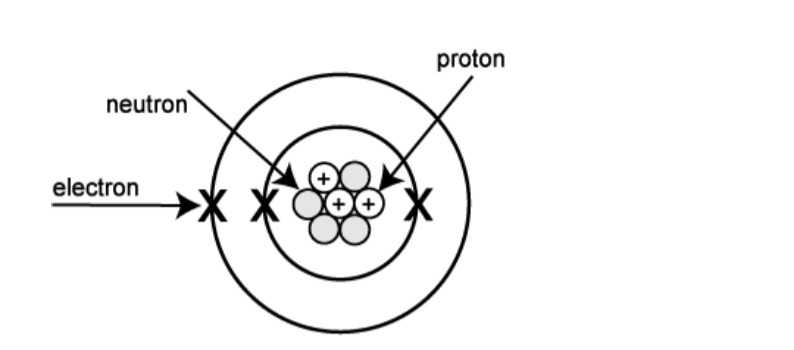
1. Electrons,
2. Protons,
3. Neutrons,
Summary of sub-atomic particles

The electrons revolve rapidly around the nucleus in fixed circular paths called energy levels or shells.
The 'energy levels' or 'shells' or 'orbits' are represented in two ways: either by the numbers 1, 2, 3, 4, 5 and 6 or by letters K, L, M, N, O and P.
The energy of the K shell is the least while those of L, M, N and O shells increases progressively. The energy levels are counted from centre outwards.
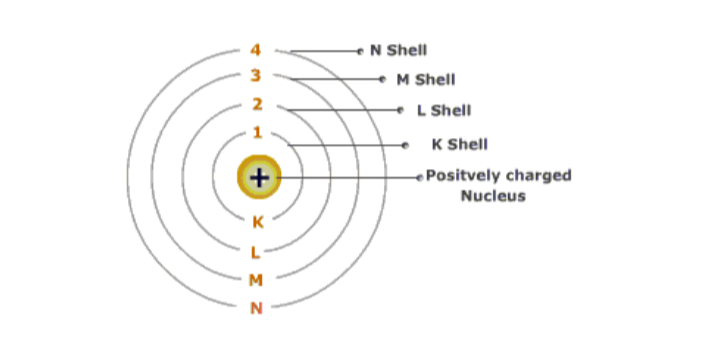
2nd energy level is L shell. It has a maximum of 8 electrons
3rd energy level is M shell. has a maximum of 8 electrons
4th energy level is N shell and so on. The 19th and 20th electrons go into the 4th shell
Electronic configuration of an element
The arrangement of electrons in the various shells/orbits/energy levels of an atom of the element is known as electronic configuration.
Important Rules: Number of electrons in a shell
Maximum number of electrons in 1st energy level = 2n2
2 x (1) 2 = 2
Maximum number of electrons in the 2nd energy level = 2n2
2 x 22 = 2 x 4 = 8
Maximum number of electrons in the 3rd energy level = 2n2
= 2x (3)2
= 2x9=18
Maximum number of electrons in the 4th energy level = 2n2
= 2x (4)2
= 2x16=32
Shell number(n) 1 2 3 4
Letter K L M N
Maximum number of electrons(2n2) 2 x (1) 2
2 x 22 2x(3)2 2x(4)2 Total 2 8 18 32

This is a very important rule and is also called the Octet rule.
The presence of 8 electrons in the outermost shell makes the atom very stable.
Geometric Representation of Atomic Structure
Example 1: Magnesium atom
Steps:
Structure 2:8:2
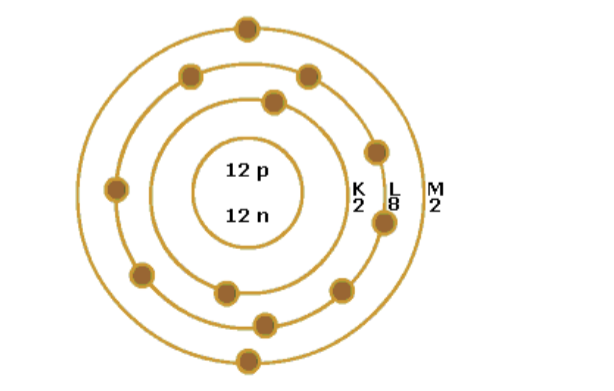
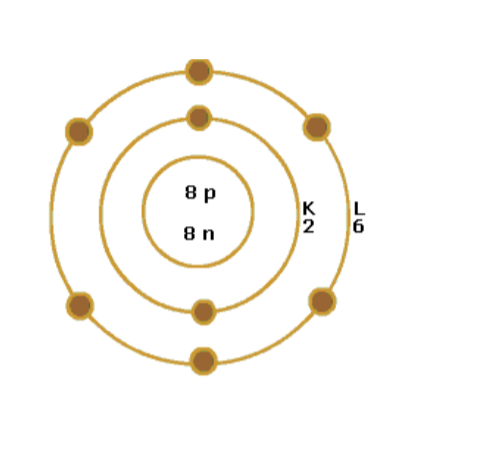
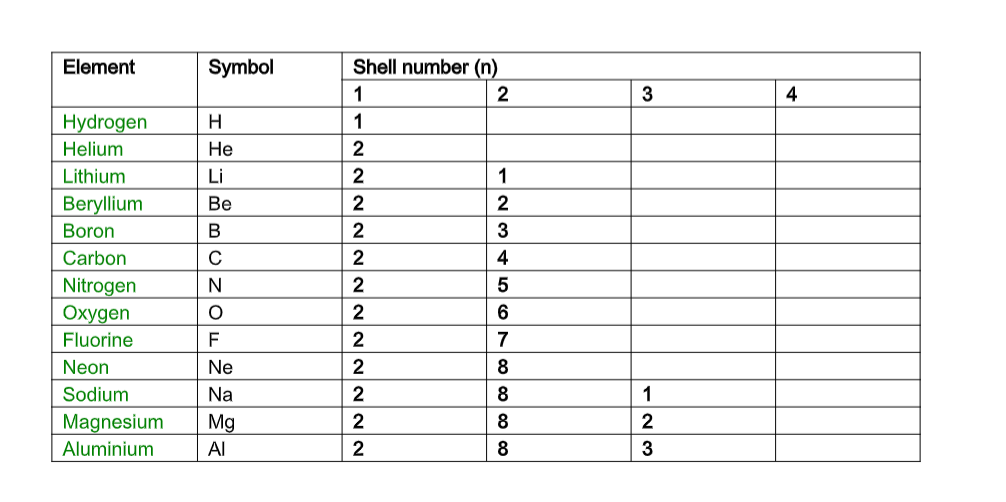

Atomic number of potassium is 19 and its electronic configuration is
K L M N
2: 8: 8: 1
Atomic number of calcium is 20 and its electronic configuration is
K L M N
2: 8: 8: 2
This abnormal behaviour can be explained as follows:
It is found that shells have sub shells. The smaller sub shells are termed s, p, d and f.
The maximum number of electrons that can go into these are 2, 5, 10 and 14 respectively.
These sub shells can overlap, resulting in energies that may differ from that predicted purely on the basis of n=1, 2, 3 etc.
Therefore when electrons start filling, they may go to a new outer shell even before the inner shell is filled to capacity.
Atomic Number and Mass Number
The nuclei of atoms are made up of protons and neutrons.
These two components of the nucleus are referred to as nucleons.
The electrons occupy the space outside the nucleus.
Since an atom is electrically neutral, the number of protons in the nucleus is exactly equal to the number of electrons.
This number is the atomic number given by the symbol Z.
Atomic number represents the number of protons in an atom.
As atoms are electrically neutral, an atom contains as many electrons as it has protons.
The total number of protons and neutrons present in one atom of an element is known as its mass number.
Mass number (A) = number of protons (Z) + number of neutrons (n)
It can also be said that:
Mass number (A) = atomic number (Z) + number of neutrons (n)
Symbols
The mass number (A) is written as a superscript on the top-left corner of the symbol of the atom. The atomic number(Z) is written as a subscript on the bottom-left corner.

The symbol represents an atom of sodium whose atomic mass is 23 and atomic number is 11. Calculate the number of protons, electrons and neutrons.
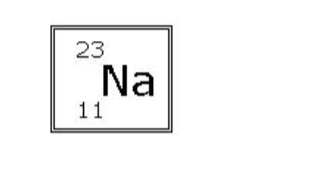
Atomic mass A = 23
No. of protons = Z = 11
No. of electrons = 11
No. of neutrons = A - Z
23 - 11 = 12
Isotopes
It is interesting to note that atoms of a given atomic number can have different number of neutrons.
Atoms of elements having the same atomic number with different mass numbers are called isotopes
Some examples are listed below:
Isotopes of Hydrogen
Hydrogen atom (Z=1) has no neutrons.
Number of protons = 1
Number of electrons = 1
Number of neutrons = 0
It has been reported that the hydrogen element has atoms with mass number 2 and 3 also i.e.
Isotopes of Chlorine
Nuclear composition of isotopes of chlorine:
Isotopes of Carbon
Nuclear composition of isotopes of carbon:
Table of some elements that exist as mixtures of isotopes
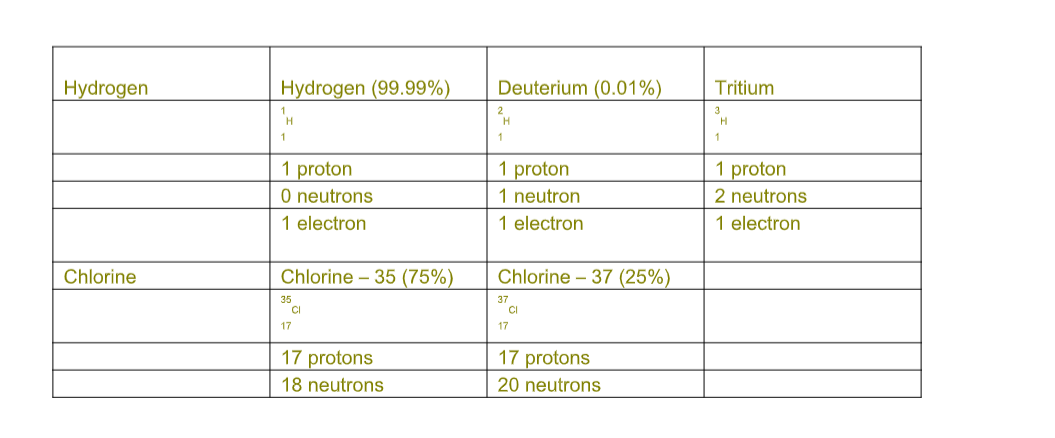

The relative atomic mass (Ar) is the average mass of an element, taking account of its natural isotopes and their percentage abundance.
The strict definition of relative atomic mass is that Ar = average mass of all the isotopic atoms present in the element compared to 1/12th the mass of a carbon-12 atom.
Example: chlorine consists of 75% chlorine-35 and 25% chlorine-37.
So the relative atomic mass of chlorine is 35.5 or Ar (Cl) = 35.5
Ion Formation
By the loss or gain of electrons a neutral atom is changed to an ion. Ions are charged atoms or a group of atoms.
In other words, ions are particles formed by atoms by the donation or acceptance of electrons.
Listed below are some elements that attain the octet configuration of Noble gases. Let us see how this happens. Study the given table:
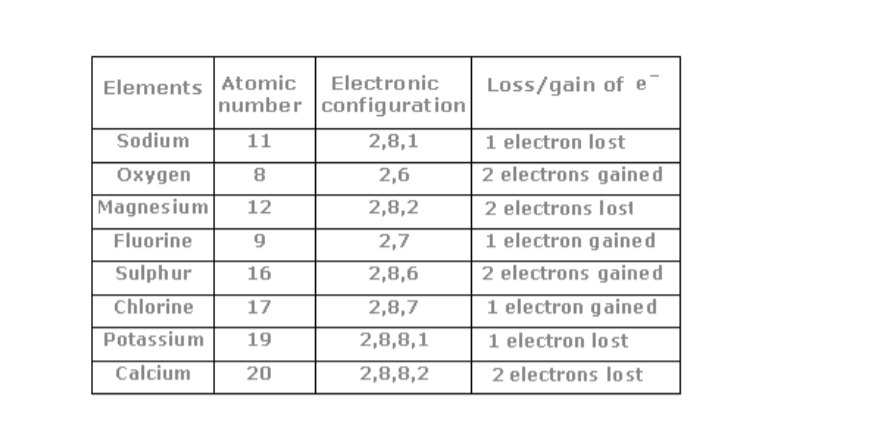
Na, Mg, K, Ca g lose electrons
S, O, F, Cl g gain electrons
Most of these atoms try to attain the configurations of either neon (2,8) or argon (2,8,8).
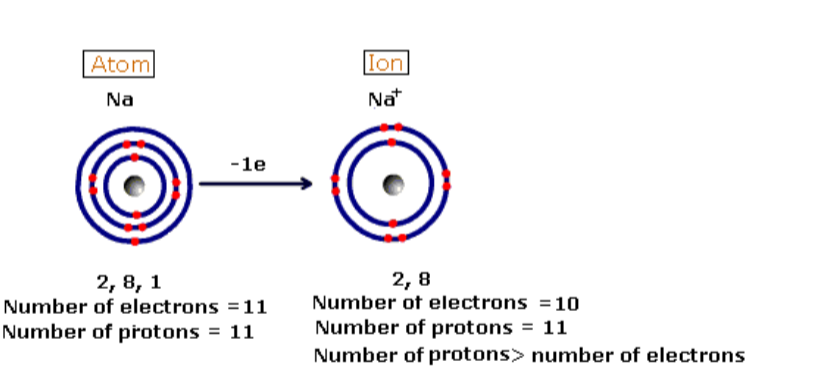
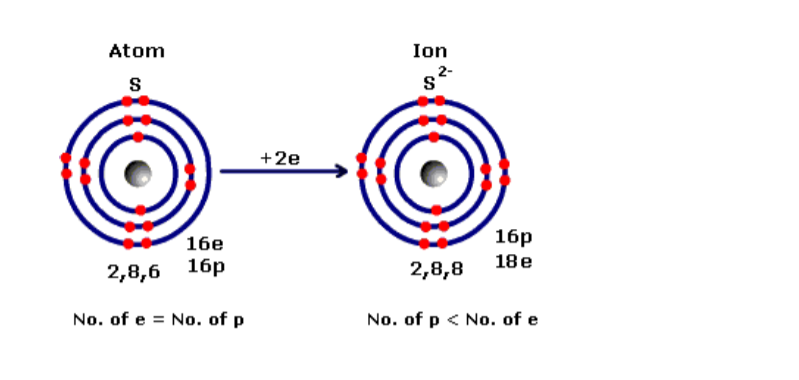
Differences between atoms and ions
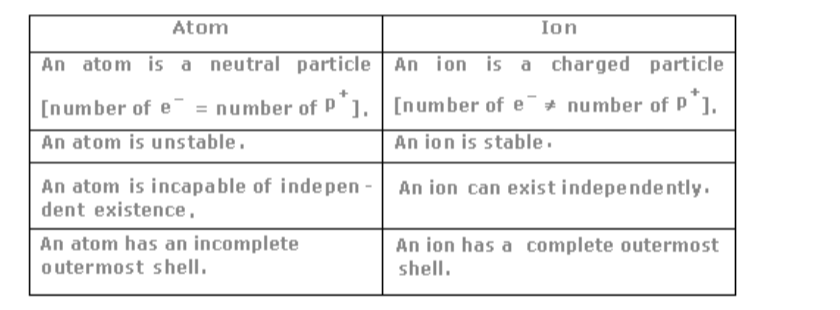
Let us consider the example of a sodium atom and the sodium ion.
Differences between sodium atom and sodium ion

1. Ionization energy
Ionization potential (or ionization energy) is the amount of energy required to remove one or more electrons from the outermost shell of an isolated atom in the gaseous state.
Atom(g) + IE Positive ion(g) + electron(g)
Thus, the ionization energy gives the ease with which the electron can be removed from an atom.
The smaller the value of the ionization energy, the easier it is to remove the electron from the atom.
An electron is held in an atom by the electrostatic force of the positively charged protons in the nucleus and the negative charge of the electrons.
By supplying enough energy, it is possible to remove an electron from an atom.
The element is first brought into the vapour state.
Then the electron is removed by supplying energy equivalent to the ionization potential.
Factors affecting ionization energy
a) The inert gases have very high ionization energy, due to the stability of the outer shell. Helium has the highest ionization energy.
b) Within a group, the ionization energy generally decreases with increasing atomic number.
Increasing atomic number results in increasing atomic radii.
Thus, the electrons of the outer shell are further away than those of the previous element and can be removed easily.
c) Ionization energy decreases down the group because of increase in the number of shells.
The effective nuclear charge decreases as atomic size increases.
Thus it is easier to pull one electron from the outermost shell of the atom.
Electron Affinity
This is the enthalpy change when 1 mole gaseous atoms gains 1 mole of electrons under standard conditions.
Cl (g) + e- Cl-(g)
The elements in group 7 have the highest electron affinities, they form negative ions easily, as go down the group the electron affinity decreases so reactivity decreases.
The second electron affinity is the energy needed to to add an electron to 1 mole of gaseous 1- ions to form 1 mole of gaseous 2- ions under standard conditions (where standard conditions are 100kpa and 298K).
Cl- (g) + e- Cl2-(g)
This process involves adding a negatively charged electron to a negative ion - naturally this process is endothermic since energy needs to be supplied to overcome the repulsive forces between the negative ion and the negative incoming electron.
Characteristics of isotopes
The densities, melting points and boiling points etc., are slightly different.
Assessment 1
1. The table shows the number of protons, neutrons and electrons in a chlorine atom.
(i) Complete the table to show the number of these particles in the chloride ion, Cl–, formed from this atom.
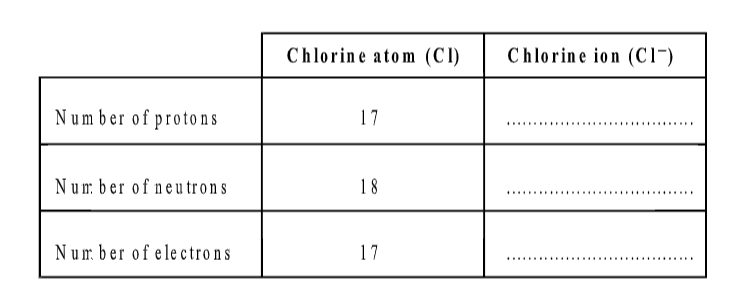
(ii) What is the arrangement of electrons in a chlorine atom?
2. The element bromine exists as a mixture of two isotopes.
(i) Complete the table to show the number of protons and neutrons in the nuclei

Deduce the percentage abundance of the two isotopes in bromine.
3. The table below shows some information about the isotopes of chlorine.
(a) Use information from the periodic table to help you complete the table.

(ii) What is the relative molecular mass of a chlorine molecule?
(c) Draw a dot and cross diagram for a molecule of chlorine, showing outer electrons only.
4. Atoms are made of electrons, neutrons and protons.
(a) Complete the table to show the relative mass and charge of an electron, neutron and proton.
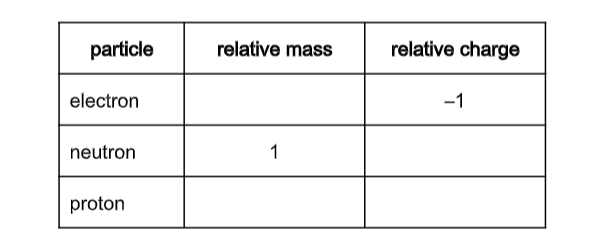
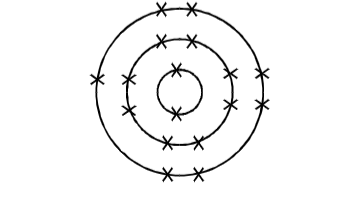
(ii) What is the atomic number of this element?
5. The electronic structures (configuration) of elements represented by letters P, Q, R and S are:
P 2.8.1 Q 2.8.7 R 2.8.2. S 2.8.8
Which element a) forms a singly charged anion
b) forms a soluble carbonate
c) reacts most vigorously with water
6. The table below shows the elements in the same group of the periodic table and their average atomic radii, measured in the usual atomic measurements.
The symbols do not represent the actual symbols of elements.
Element Atomic radius

(b) Using the letters given, which element has the highest ionisation energy? Give a reason for your answer
1.3 The Periodic Table
Dmitri Mendeleev is credited as being the Father of the modern periodic table.
In 1869 he arranged the 50 or so known elements in order of atomic number, Z, putting elements with similar properties in the same vertical group, and leaving gaps for unknown elements, yet to be discovered.
When the elements were later discovered, they were found to have the properties predicted by Mendeleev's table.
Groups and Periods
Elements in the same period have the same number of shells, but the number of electrons occupying the last shell increase from left to right i.e. from one to eight.
The number of shells increases down a group.
However, the number of electrons in the last shell of each element is the same.
Elements in a given group in the periodic table share many similar chemical and physical properties.
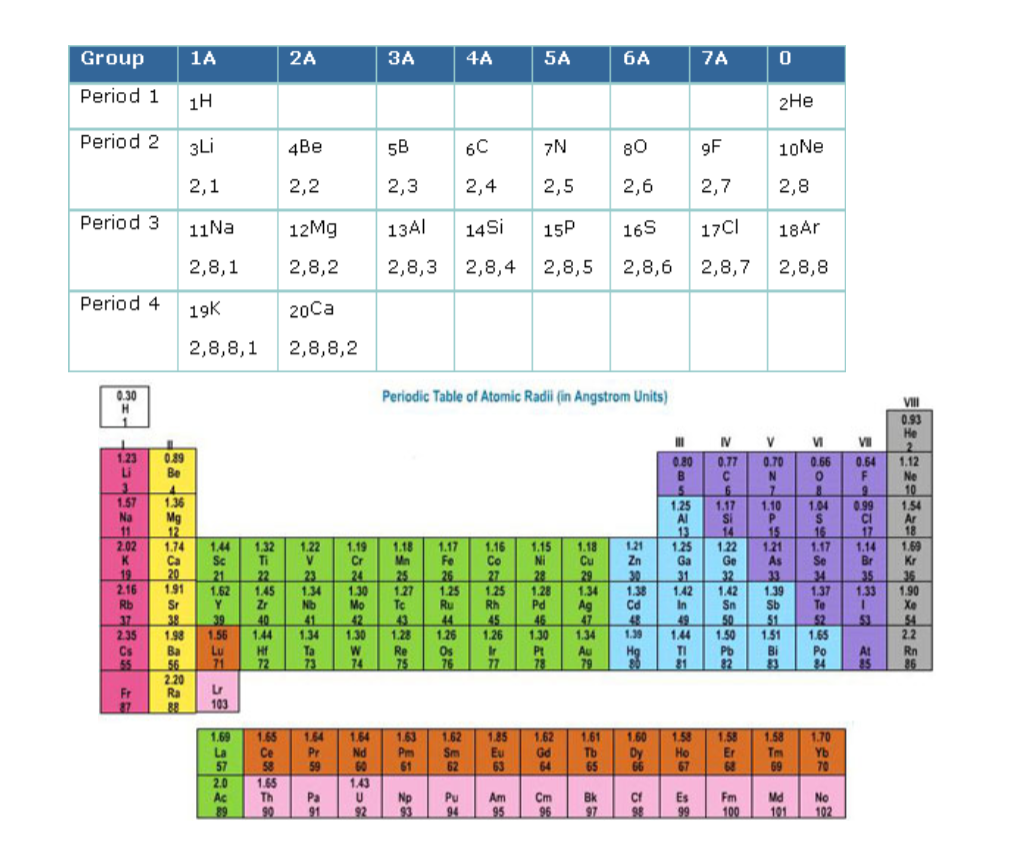
The modern periodic table is very useful for giving a summary of the atomic structure of all the elements.
Some of the Groups have Names and some have Numbers.
7.0.0 Chemical Families
Patterns and Properties
A Group is a vertical column of chemically and physically similar elements. The alkali metals are in group 1 on the left of the periodic table.
The elements in this group are Hydrogen (H), Lithium (Li), Sodium (Na), Potassium (K), Rubidium (Rb), Cesium (Cs) and Francium (Fr) They have all only one electron in their outermost shells.
Since the atomic number, hence number of shells increases down the group, the atomic radius increases down the group.
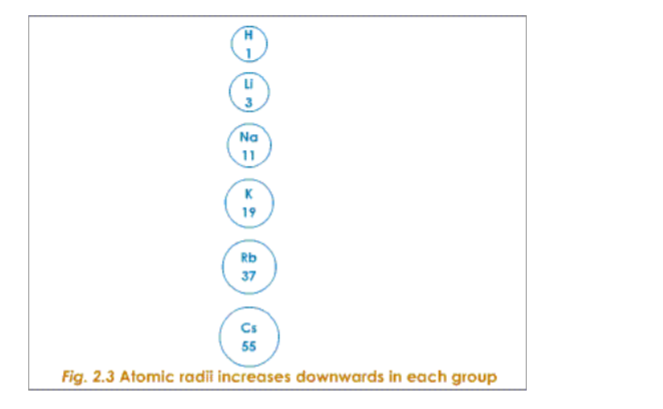
From one element to the next, an extra shell of electrons is added. This increases the electron 'bulk' and the outer electrons are increasingly less strongly held .
The radii of the adjacent Group 2 atom is smaller than Group 1 atom on the same period, because the nuclear charge has increased by one unit (L to R ), but is attracting electrons in the same shell.
Similarly the radii of Group 2 M2+ ion is smaller than the adjacent Group 1 M+ ion on the same period, because the nuclear charge has increased by one unit (L to R ), but is attracting the same number of electrons in the same shells.
The alkali metals are all highly reactive, losing their one outer electron to form a 1+ ion with non-metals. They give up 1 electron easily as losing 1 is easier than gaining 7 to complete the octet.
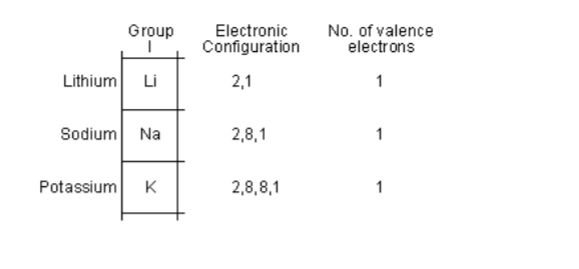
They are unusually soft, and can easily be cut with a knife.
When freshly cut, they rapidly tarnish by reaction with oxygen to form an oxide layer, which is why they are stored under oil.
The first three members, lithium, sodium and potassium, are unique in being the only metals which are less dense than water (they float!).
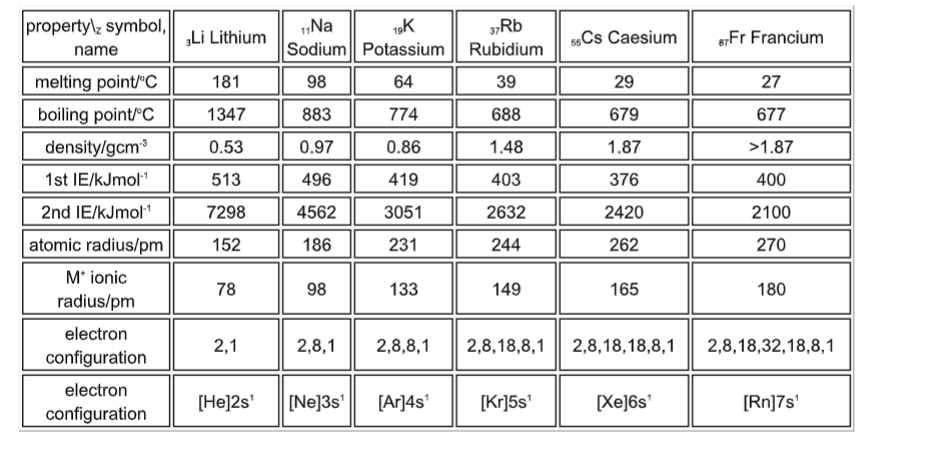
This is the energy required to remove one mole of electrons from the outermost shell of an atom to form a positively charged ion.
M(g) M+(g) + e-
This process can be repeated again to give the second ionisation energy.
This is more difficult than the first ionisation energy because we are removing a negative electron from a positive ion.
M+(g) M2+(g) + e-
And again......
M2+(g) M3+(g) + e-
It is possible to continue in this way until al of the electrons on an atom have been removed.
As you go down the group from one element down to the next, the atomic radius gets bigger due to an extra filled electron shell.
The outer electrons are further and further from the nucleus and are also shielded by the extra full electron shell of negative charge.
Therefore the outer electrons are less and less strongly held by the positive nucleus and so less and less energy is needed to remove them.
Successive ionisation energies always increase e.g. ... 3rd > 2nd > 1st, because the same nuclear charge is attracting fewer electrons and on average closer to the nucleus.
BUT note the 2nd IE for Group 1, and the 3rd IE for Group 2, show a particularly significant increase in IE compared to the previous ionisation energy or energies.
This is due to removing an electron from an electronically highly stable full inner shell and puts an upper limit on the chemically stable oxidation state.
Why reactivity increases down the group
When an alkali metal atom reacts, it loses an electron to form a singly positively charged ion e.g. Na Na+ + e- (in terms of electrons 2.8.1 2.8 and so forming a stable ion with a noble gas electron arrangement).
As you go down the group from one element down to the next the atomic radius gets bigger due to an extra filled electron shell.
The outer electron is further and further from the nucleus and is also shielded by the extra full electron shell of negative charge.
Therefore the outer electron is less and less strongly held by the positive nucleus.
This combination of factors means the outer electron is more easily lost, the M+ ion more easily formed, and so the element is more reactive as you go down the group.
The reactivity argument mainly comes down to increasingly lower ionisation energy down the group.
Summary of the Reactivity Trend of Alkali Metals
Uses of Alkali Metals
Sodium Na+ salts
1. Common salt from sea water or underground deposits is sodium chloride and is the raw material for making sodium, hydrogen, chlorine and sodium chloride by electrolysis.
2. Sodium hydrogen carbonate (NaHCO3) Used in baking soda, pharmaceutical products like indigestion tablets and fire extinguishers.
3. Sodium hydroxide (NaOH) Used in the manufacture of soaps, detergents, salts of acids, paper and ceramics.
The Alkaline Earth Metals - Group 2 - Properties.
The second group (group II A) has Beryllium (Be), Magnesium (Mg), Calcium (Ca), Strontium (Sr), Barium (Ba) and Radium (Ra).
They have two electrons in their last shell and their valence is +2 as they give up two electrons to form compounds.
The elements in group II A are not as metallic as the alkali metals.
They form oxides easily and are known as alkali earth metals.
Group 2 Alkaline Earth Metals


Mg Mg2+ + 2e-
Ca Ca2+ + 2e-
From calcium going down the group, they have to be stored under oil, or they react with oxygen in the air. They are less reactive than the alkali metals (Group 1).
Calcium and magnesium are fourth and fifth in the reactivity series.
They all have the common properties of metals, being silvery-grey in colour, and good conductors of heat and electricity.
They are less soft than the alkali metals, and it is difficult to cut them with a knife.
The only two of the group which are studied at KCSE are magnesium and calcium.
Strontium, barium and radium are all too reactive or unstable to be used.
All you need to know about these three is that they have the same chemical properties as magnesium and calcium.
Beryllium is odd and is not studied at KCSE.
It would be expected to lose its two outer electrons like the rest of Group 2 but beryllium is so small that it doesn't like to lose two electrons.
Its compounds have covalent character! As we proceed to group III and further, we will notice that the number of valence electrons increases by one in each subsequent group.
Trend in first ionization energy down group 2


The first ionisation energy is the enthalpy change when one mole of gaseous atoms forms one mole of gaseous ions with a single positive charge. It is an endothermic process, i.e. is positive.
A general equation for this enthalpy change is:
Ionisation energy is governed by:
• The charge on the nucleus,
• The amount of screening by the inner electrons,
• The distance between the outer electrons and the nucleus.
Going down Group 2:
How does the first ionisation energy change going down the group?
The outer electrons are held in their shells by the attractive force of the positive protons in the nucleus, the nuclear attraction.
As more and more electron shells are added this force gets weaker because
1. the distance between the outer electrons and the nucleus is increasing
2. The inner electrons shield the nuclear electrons from the outer electrons, electronic shielding.
The lower the ionisation energy the easier it is to remove electrons from the outermost shell of the atom.
As you go down a group the ionisation energy decreases.
This also explains why metals get more reactive as you go down a group.
It gets easier for them to give up electrons to form bonds.
As the number of protons in the nucleus increases going down Group 2, you might expect the first ionisation energy to increase because the nuclear charge increases.
This does not happen, because the factors described above have a greater influence on the value of the first ionisation energy.
Trend in atomic radius
Going down Group 2:
There are more filled energy levels between the nucleus and the outer electrons, therefore the outer electrons are more shielded from the attraction of the nucleus So the electrons in the outer energy levels are further from the nucleus and the atomic radius increases.
As the number of protons in the nucleus increases going down Group 2, you might expect the atomic radius to decrease because the nuclear charge increases.
This does not happen, because although the electrons in the inner energy levels become closer to the nucleus, the factors described above have a greater influence on the atomic radius overall.
Reaction With Air
Magnesium burns vigorously with a bright white flame when strongly heated in air/oxygen to form a white powder of magnesium oxide.
Magnesium + oxygen magnesium oxide
2Mg(s) + O2(g) 2MgO(s) Calcium burns quite fast with a brick red flame when strongly heated in air/oxygen to form the white powder calcium oxide.
Calcium + oxygen calcium oxide
2Ca(s) + O2(g) 2CaO(s)
Reaction With Water
1. Magnesium will not react with cold water. Even finely powdered magnesium reacts only very slowly. Magnesium will react with gaseous water (steam) to form magnesium oxide and hydrogen. Magnesium + steam magnesium oxide + hydrogen.
Mg(s) + H2O(g) MgO(s) + H2(g)
Magnesium oxide is a base. It will not dissolve in water.
In fact magnesium is so reactive, it will even burn in carbon dioxide, the products being white magnesium oxide powder and black specks of elemental carbon!
Magnésium + carbon dioxide ==> magnesium oxide + carbon 2Mg(s) + CO2(g) ==> 2MgO(s) + C(s)
2. Calcium (and the metals below calcium in group 2) will react with cold water. They will sink as they react, unlike the group 1 metals which float.
Calcium + water calcium hydroxide + hydrogen. Ca(s) + 2H2O(l) Ca(OH)2(s) + H2(g)
Calcium hydroxide is called slaked lime and will dissolve a little in water to form lime water
Reaction With Acids
Magnesium is very reactive with dilute hydrochloric acid forming the colourless soluble salt magnesium chloride and hydrogen gas.
Magnesium + hydrochloric acid ==> magnesium chloride + hydrogen Mg(s) + 2HCl(aq) ==> MgCl2(aq) + H2(g)
Magnesium is very reactive with dilute hydrochloric acid forming the colourless soluble salt calcium chloride and hydrogen gas.
Calcium + hydrochloric acid ==> calcium chloride + hydrogen
Ca(s) + 2HCl(aq) ==> CaCl2(aq) + H2(g)
Not very reactive with dilute sulphuric acid because the colourless calcium sulphate formed is not very soluble and coats the metal inhibiting the reaction, so not many bubbles of hydrogen.
Calcium + sulphuric acid ==> calcium sulphate + hydrogen
Ca(s) + H2SO4(aq) ==> CaSO4(aq/s) + H2(g)
Reaction With Halogens
They occur in nature only in compounds because of their high reactivity.
They are less reactive than group 1 elements due to higher IE.
They react with elements in group 7 to give the general formula MX2(M is the metal and X represents any members of group 7.
M + X2 --> MX2 Example Mg + Br2 --> MgBr2
Summary of the Reactivity Trend of Alkali Earth Metals
As the atomic radius increases and the electron is further from the nucleus it is less attracted to the nucleus (electron is said to be 'shielded')
As successive electron 'shells' (energy levels) are filled, the electron is further from the positively charged nucleus, and therefore less attracted to it, making the electron easier to remove.
As successive electron 'shells' (energy levels) are filled, the electron is further from the positively charged nucleus, and therefore less attracted to it, making the electron easier to remove.
This is because it is harder to remove the electron since there are more positive charges (protons) in the nucleus than there are negative charges (electrons in 'shells'), hence the electron's attraction to the nucleus is greater.
When 2 electrons have been removed from the gaseous atom, the remaining electrons are arranged like a noble gas, which is a very stable electron configuration.
It is very difficult to remove an electron from this arrangement.
The Halogens - Group 7.
The halogens are all in group 7 on the right of the periodic table. This group consists of elements like Fluorine (F), Chlorine (Cl), Bromine (Br), Iodine (I), Astatine (At).
The Halogens are typical non-metals and form the 7th Group in the Periodic Table 'Halogens' means 'salt formers' and the most common compound is sodium chloride which is found from natural evaporation as huge deposits of 'rock salt' or the even more abundant as 'sea salt' in the seas and oceans.
Physical properties
• Typical non-metals with relatively low melting points and boiling points.
• The melting points and boiling increase steadily down the group (so the change in state at room temperature from gas => liquid => solid), this is because the inter molecular attractive forces increase with increasing size of atom or molecule.
• They are all coloured non-metallic elements.
• The colour of the halogen gets darker down the group.
• They are all poor conductors of heat and electricity - typical of non-metals.
• When solid they are brittle and crumbly e.g. iodine.
• The size of the atom gets bigger as more inner electron shells are filled going down from one period to another.
Chemical properties
The atoms all have 7 outer electrons, this outer electron similarity, as with any Group in the Periodic Table, makes them have very similar chemical properties eg
They gain one negative electron (reduction) to be stable and this gives a surplus electric charge of -1.
These ions are called the halide ions, two others you will encounter are called the bromide Br- and iodide I- ions.
The bonding in the molecule involves single covalent bonds e.g. hydrogen chloride HCl or H-Cl
• The reactivity decreases down the group.
• They are all TOXIC elements.
• Astatine is very radioactive, so difficult to study but its properties can be predicted using the principles of the Periodic Table and the Halogen Group trends!
Group 7 ( Halogens )
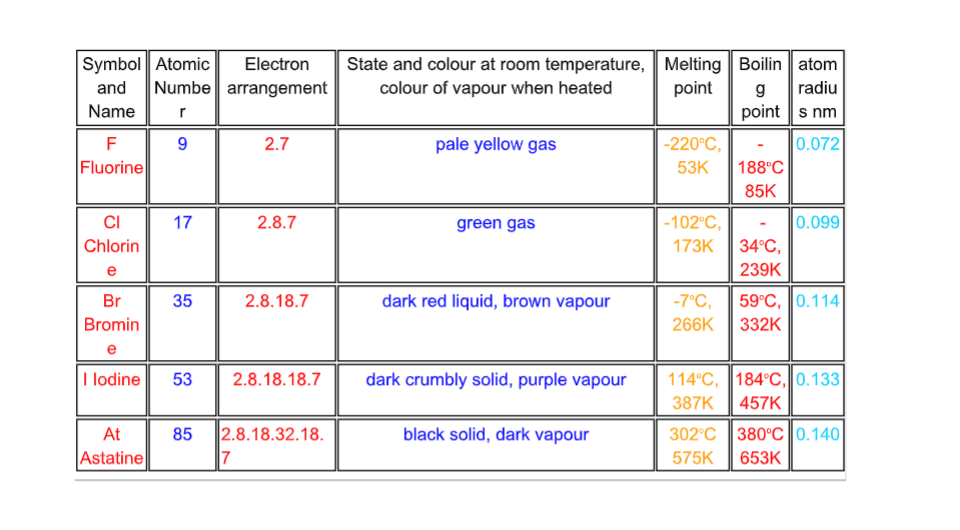
These elements are gaseous in nature and have valence -1, they borrow electrons to stabilize their electronic configuration.
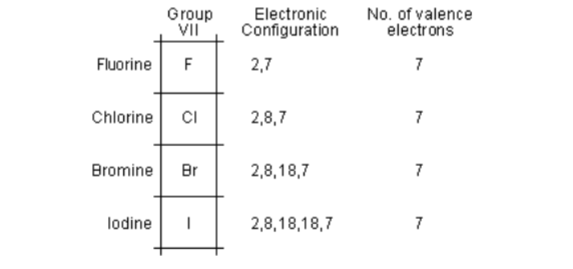
The formulae are F2, Cl2, Br2, I2, (see structure of chlorine).
All of the halogens will either.
1) Gain one electron from a metal to form an ionic bond, or
2) share one electron with a non-metal to form a covalent bond
Reactions with Metals.
The halogens will gain one electron to form an ionic bond with metals. The halogens will react with
1) Group 1 metals
• Alkali metals burn very exothermically and vigorously when heated in chlorine to form colourless crystalline ionic salts eg NaCl or Na+Cl-.
This is a very expensive way to make salt! Its much cheaper to produce it by evaporating sea water!
eg sodium + chlorine ==> sodium chloride
2Na(s) + Cl2(g) ==> 2NaCl(s)
• The sodium chloride is soluble in water to give a neutral solution pH 7, universal indicator is green.
The salt is a typical ionic compound ie a brittle solid with a high melting point.
Similarly potassium and bromine form potassium bromide KBr, or lithium and iodine form lithium iodide LiI.
Again note the group formula pattern.
1) Transition metals
Iron + bromine iron (III) bromide.
2Fe(s) + 3Br2(l) 2FeBr3(s)
Iron + chlorine iron(III) chloride.
2Fe(s) + 3Cl2(g) 2FeCl3(s) All of the compounds with metals are ionic salts which form a giant structure.
They are called metal halides because they are formed from a metal and a halogen.
Testing halide ions.
Halide ions undergo a series of unique reactions that allow an unknown solid or aqueous sample to be tested for the presence of chloride, bromide or iodide ions.
Aqueous silver ions react with halide ions to produce individually coloured precipitates. These precipitates have different solubilities in ammonia solution and so further differentiation can be achieved, see the table below,


(Typically, metals have low electro negativity, little ability to attract electrons, while non-metals have high electro negativity, greater ability to attract electrons).
The reactivity of Group VII elements is related to the element's ability to attract electrons, so the greater the electro negativity, the more reactive the Halogen.
So, chemical reactivity of Group VII elements decreases down the Group, from the most reactive (Fluorine) to the least reactive (Iodine).
Similarly there is a gradation in physical appearance at STP, from gas to liquid to solid, as the elements become more metallic in nature.
Uses of Halogens
1. Chlorine by itself is used as bleach and in the manufacture of sodium chlorate, which can be used as bleach and a herbicide.
2. Water purification also relies on chlorine to kill bacteria in the water, after the impure water has passed through various filtration stages.
3. Chlorine is also used in the production of chlorofluorocarbons, commonly called CFC's, used in the past as refrigerant gases and propellants for aerosol cans.
Both these uses have now been banned by international law, in the developed world at least.
4. The problem these chemicals cause is that when they reach the high atmosphere the molecules break apart to release chlorine atoms.
These chlorine atoms then react with molecules of ozone, O3, turning them into molecules of oxygen. One chlorine atom can destroys thousands of molecules of ozone.
Ozone traps UV light from the sun, preventing it hitting the surface of the Earth, and with a depletion of ozone more UV light gets through, which increases occurrences of skin cancer in humans.
5. Fluorine is used as fluoride salts in toothpaste or added to domestic water supplies to strengthen teeth enamel helping to minimise tooth decay. (eg potassium fluoride).
6. Bromine and iodine are both used in 'halogen' car headlamps.
7. Iodine is used in hospitals in the mild antiseptic solution 'tincture of iodine'.
The Noble Gases - Group 0.
In this group, we have Helium (He), Neon (Ne), Argon (Ar), Krypton (Kr), Xenon (Xe) and Radon (Rn).
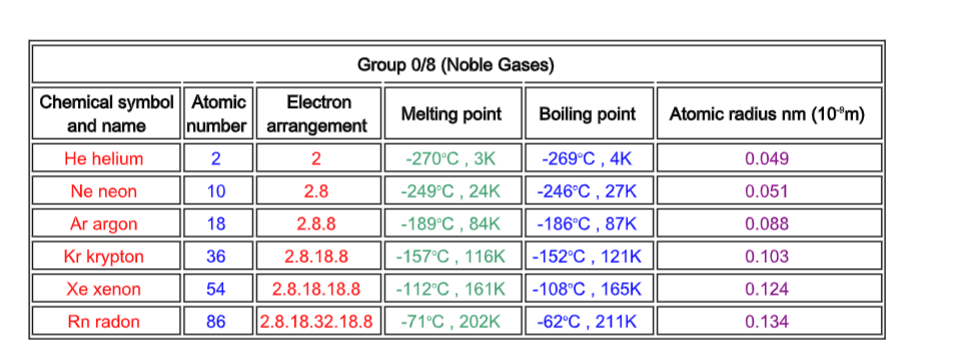
These elements are therefore chemically non-interacting and inert. They are therefore gaseous in nature.
They are Noble gases or inert gases.
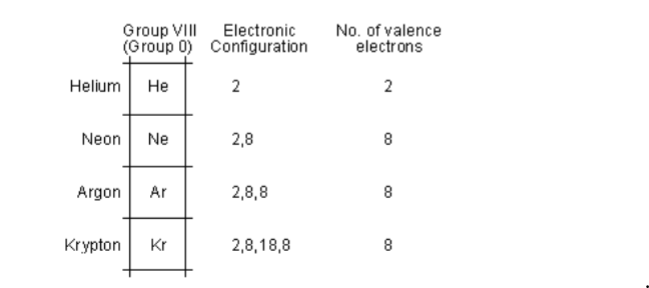
Monatomic means that they exist as single atoms. The forces between the atoms are very weak (and so they are gases).
Going down the group from helium to radon, the density increases.
The melting and boiling point increases because the atoms become heavier (bigger) and require more energy to melt or boil.
Summary of Noble Gases
• The "Noble Gases" are the last group in the Periodic Table i.e. they form the last elements at the end of a period.
• They are all non-metallic elements and all are colourless gases at room temperature and pressure with very low melting points and boiling points.
• They form 1% of air, and most of this is argon. All the noble gases, except radon, are separated by the fractional distillation of liquified air.
Helium can also be obtained from natural gas wells where it has accumulated from radioactive decay (alpha particles become atoms of helium gas when they gain two electrons).
• They are very unreactive elements because the highest occupied electron level is complete, meaning they have a full shell of outer electrons!
They have no 'wish' electronically to share electrons to form a covalent bond or to lose or gain electrons to form an ionic bond. In other words, they are electronically very stable.
• They exist as single atoms, i.e. they are monatomic He Ne Ar etc.
(NOT diatomic molecules as with many other gases).
• Their very inertness is an important feature of their practical uses.
• Down the Group with increasing atomic number:
Variation of Atomic Radius Down the Group
As we move down the group, the atoms get bigger as more electron shells are added. One full shell i.e. a set of 8 electrons is added from one element to the next.
This means that the atomic number and mass number both increase as we move down the group.
We can observe here that all the group member elements have the same valence electrons and display same valencies.
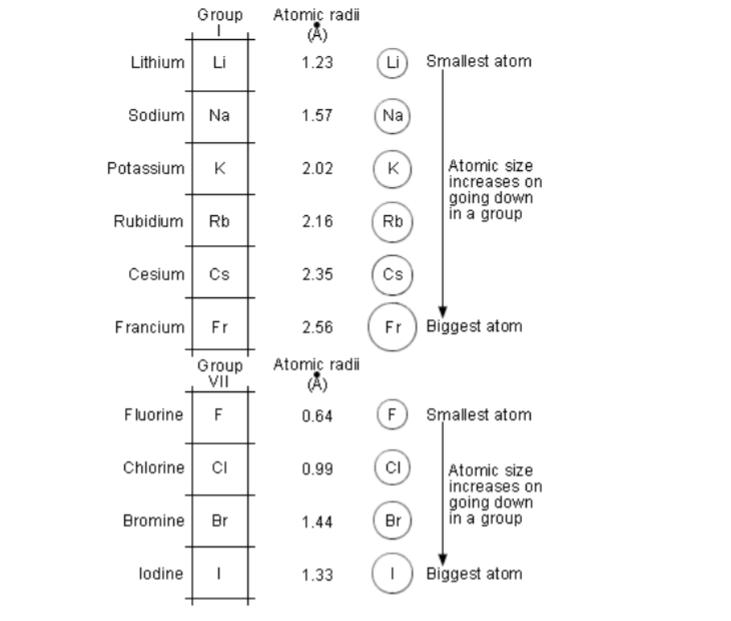
On going down a particular group, the properties of elements get enhanced. For example, the figure below shows group I A, the alkali metal elements.
As the atomic radii increases in the alkali metal elements, the last electron is farther away from the attractive forces of the nuclear charge.
So it is relatively easy for the element to give up its last electron.
And hence show more metallicity.
To say it in terms of electro positive character of elements, we can say that the electro positive character increases as we go down the group I.
Now if we see the behaviour of elements in the group VII or the halogen elements, we see that the electro negative character reduces as we go down the group.
This means that fluorine (F) is more reactive than chlorine (Cl).
The reason for this is that the orbit where the extra electron is captured is closer to the nucleus in F than in Cl.
Thus the extra electrons get attracted into the F-atom in a stronger manner than that in Cl.
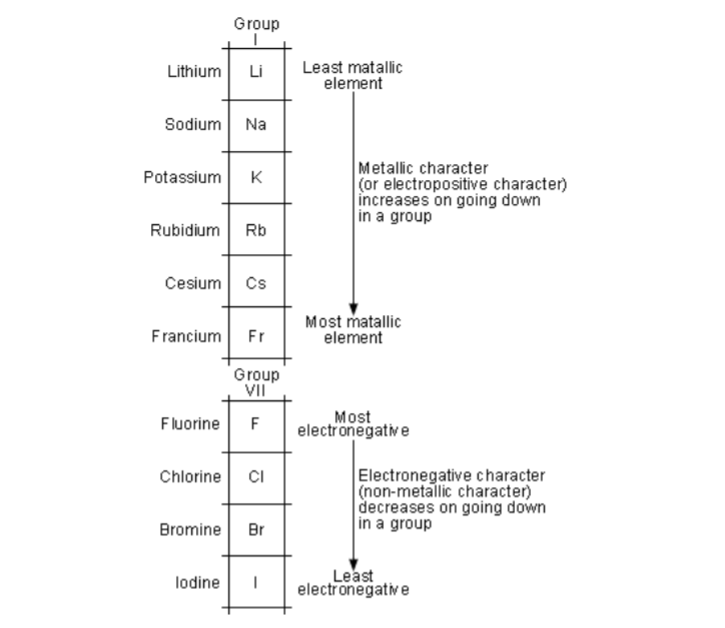
As far as chemical reactivity is concerned, we can see that in group I, the reactivity increases as we go down the group.
On the other hand, in the other extreme, in group VII A, the reactivity decreases as we go down the group.
Also group VIII A consisting of noble gases is completely unreactive.
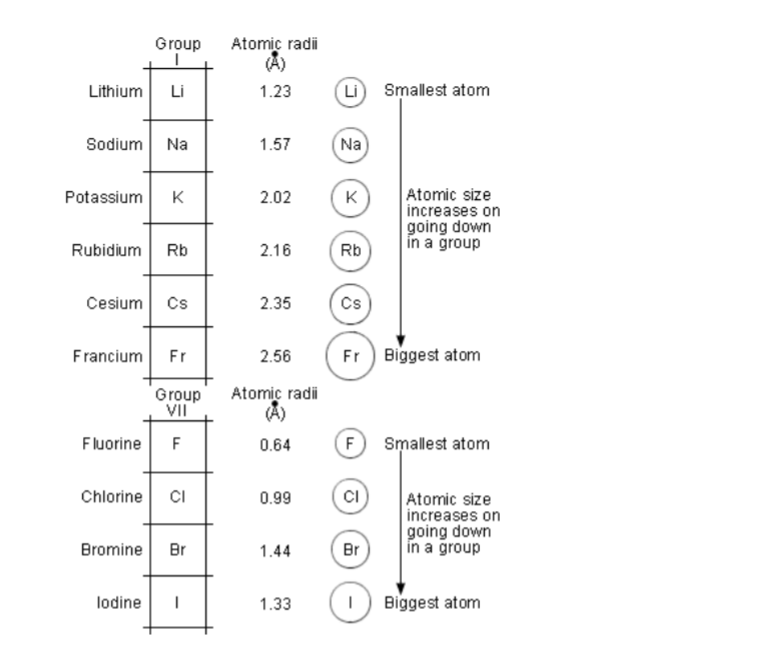
• The atomic numbers are not consecutive.
• The number of valence electrons in the elements is same in a group.
• The elements of the same group have the same valencies. The atomic radii increase while going from top to bottom in a group.
• Metallic character increases while going from top to bottom in a group for metallic groups.
For non-metallic groups, the non-metallic nature decreases while going from top to bottom
• Chemical reactivity increases while going from top to bottom in a group for metallic groups.
For non-metallic groups, the chemical reactivity decreases while going from top to bottom.
Periods
: Characteristics of periods
The first period starts with hydrogen (H) and ends with helium (He). It has just two elements H (Z=1) and He (Z = 2).
H has one electron in the first-shell. He has 2 electrons in the first-shell.
As we have seen in the chapter on the structure of atoms, the first-shell can hold only 2 electrons.
Thus the first period is complete.
It has to be borne in mind that the place of hydrogen is unique in the periodic table.
It has been placed above the alkali elements starting with Li in group 1A.
This is because H has valency 1 just as the other alkali elements.
But the properties of hydrogen otherwise are very different from the other group 1A alkali elements Li, Na, K, Cs, etc.
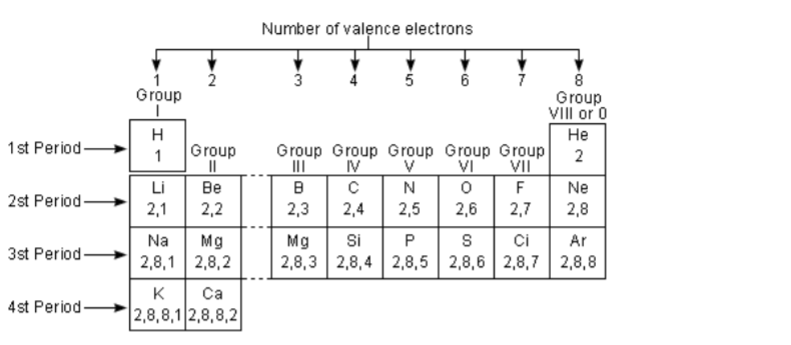
The second period starts with Li (Z=3), where the first-shell is filled and the next shell is starting to fill. After Li the next element is beryllium (Be, Z=4).
Its first-shell is complete and it has 2 electrons in the second shell. The maximum number of electrons held in the second shell is 8.
So the period has 8 elements, in which each element’s second shell is getting filled.
The last element in the period is neon (Ne, Z=10).
Neon’s both first and the second shell are completely filled.
A similarly situation occurs for the third period.
Here the next shell after second shell or the third shell is getting filled.
The maximum number of electrons in the third shell is 8.
Thus across the period, starting with element sodium (Na, Z=11) the third-shell has 1 electron; and the period ends with argon (Ar, Z= 18) which has 2 electrons in the first, 8 electrons in the second shell and 8 electrons in the third shell.
Trends Across Period 3
Now let us look at some of the chemical and physical properties in a particular period. What we will learn from one period, will hold true for all the other periods.
Consider the third period.
The figure below shows how the electronic configuration is changing as we go from left to right in the period.
The number of valence electrons is increasing in an integral fashion.
The change in the valency is according to the tendency to give up or borrow electrons.
Thus elements in the same period have consecutive atomic numbers and different valencies.
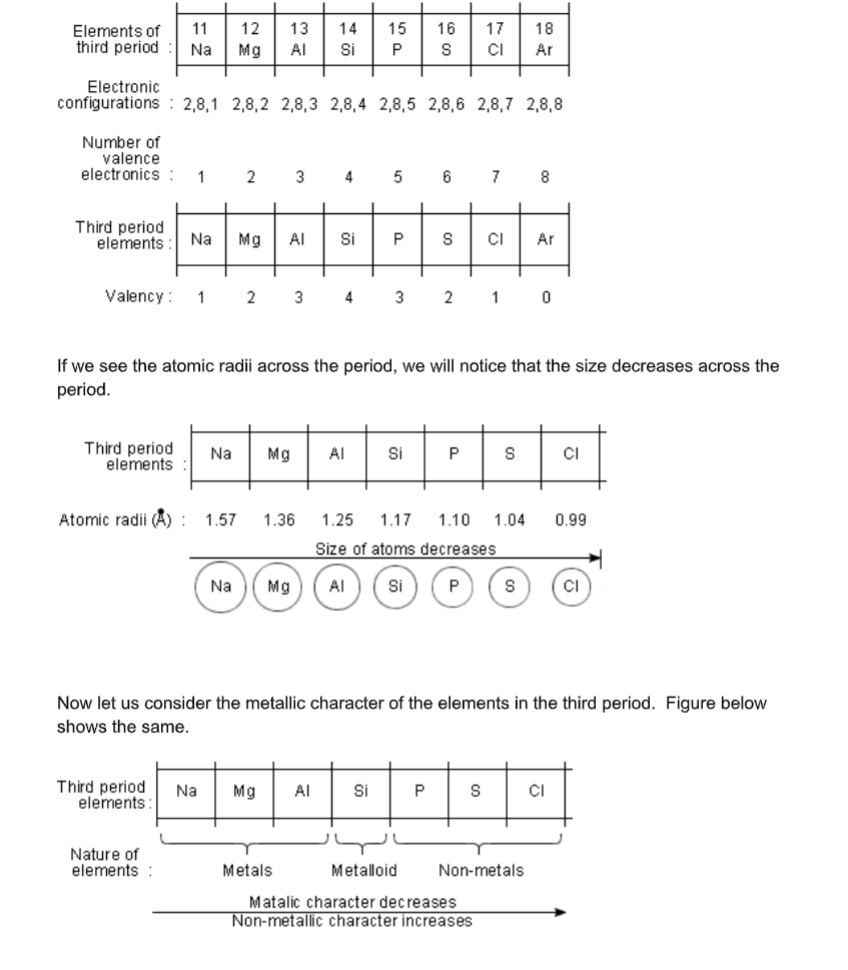
Now let us consider the metallic character of the elements in the third period. Figure below shows the same.
We have proper metals in the first and the second places: sodium (Na) and magnesium (Mg) are alkali and alkaline-earth metals.
They give up the electrons in the last shell very easily.
They are shiny in colour and conduct electricity.
After Mg comes aluminum (Al).
Al has 3 electrons in its outermost shell and behaves like a metal.
The next element is silicon (Si).
It has 4 electrons in its outermost shell.
It thus needs to borrow four electrons or give up all its four electrons to form a stable shell.
Si does not do any of these, instead it binds tetrahedrally most of the time.
Thus Si behaves neither like a metal nor like a non-metal.
Hence it is called as a metalloid. After Si, come three elements: phosphorus (P), sulphur (S) and chlorine (Cl).
All the three are non-metals.
Thus while moving from left to right in the period, the metallicity decreases.
Also the chemical reactivity first decreases and then increases.
As discussed before, the chemical reactivity depends on how easily the outermost orbit gives off or borrows electrons to make a stable orbit.
The two extremes of the third period, namely Na and Cl are very reactive.
But Na is very electro-positive in nature, where as Cl is very electro-negative in nature.

The next oxide, namely magnesium oxide is also basic in nature.
At the other extreme, chlorine oxide, sulphur oxides and phosphorus oxides are acidic in nature.
The mid-elements like Al, Si have their oxides behave in both acidic and basic manner, depending on the oxidation conditions.
Such oxides are said to be amphoteric in nature.
First Ionisation Energy Across Period 3
First ionisation energy generally increases going across Period 3.
However, it needs more detailed consideration than the trend in Group 2 because:
• The first ionisation energy drops between magnesium and aluminium before increasing again.
• The first ionisation energy drops between phosphorus and sulphur before increasing again.
Table of physical data

General increase across the period
The first ionisation energy is the enthalpy change when one mole of gaseous atoms forms one mole of gaseous ions with a single positive charge.
It is an endothermic process, i.e. is positive.
A general equation for this enthalpy change is:
Going across Period 3:
• there are more protons in each nucleus so the nuclear charge in each element increases ...
• therefore the force of attraction between the nucleus and outer electron is increased, and ...
• there is a negligible increase in shielding because each successive electron enters the same energy level ...
• so more energy is needed to remove the outer electron.
Trend in atomic radius of Period 3 elements
Atomic radius decreases going across Period 3.
Table of physical data
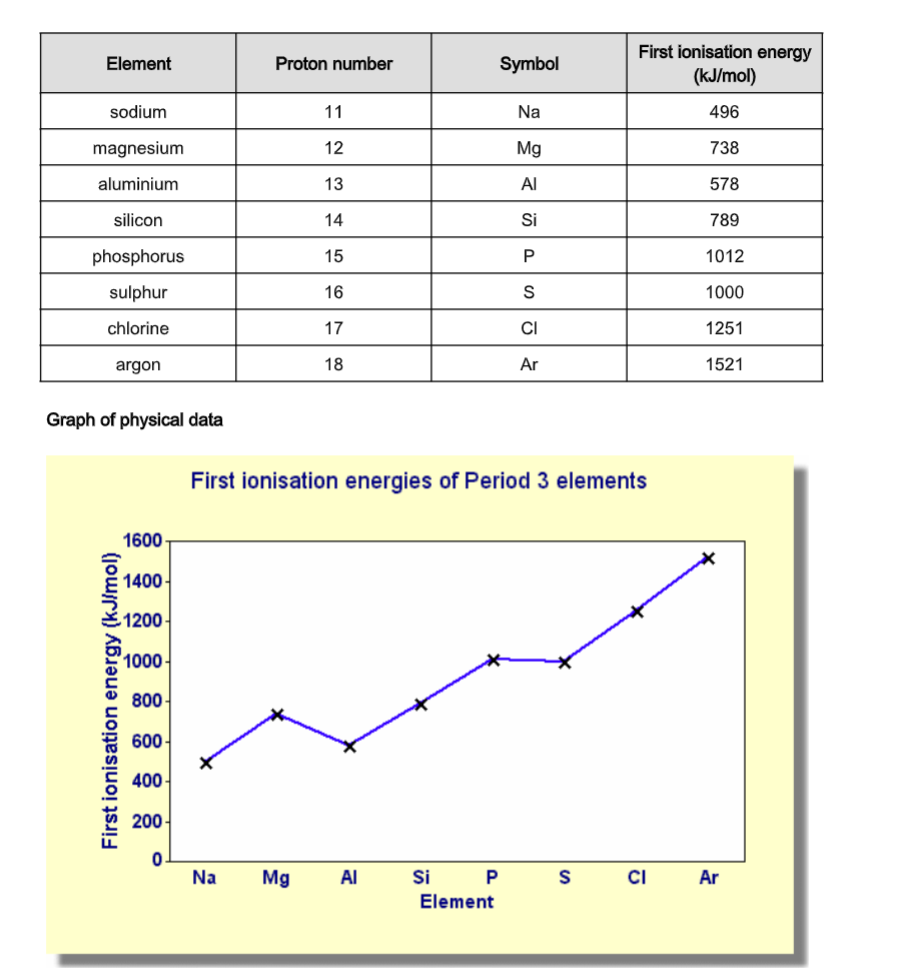
Going across Period 3:
• the number of protons in the nucleus increases so ...
• the nuclear charge increases ...
• there are more electrons, but the increase in shielding is negligible because each extra electron enters the same principal energy level ...
• therefore the force of attraction between the nucleus and the electrons increases ...
• So the atomic radius decreases.
As the number of electrons in each atom increases going across Period 3, you might expect the atomic radius to increase.
This does not happen, because the number of protons also increases and there is relatively little extra shielding from electrons in the same principal energy level.
Trend in electrical conductivity
Electrical conductivity increases going across Period 3 from sodium to aluminium, then decreases to silicon.
The remaining elements have negligible conductivity.
Table of physical data
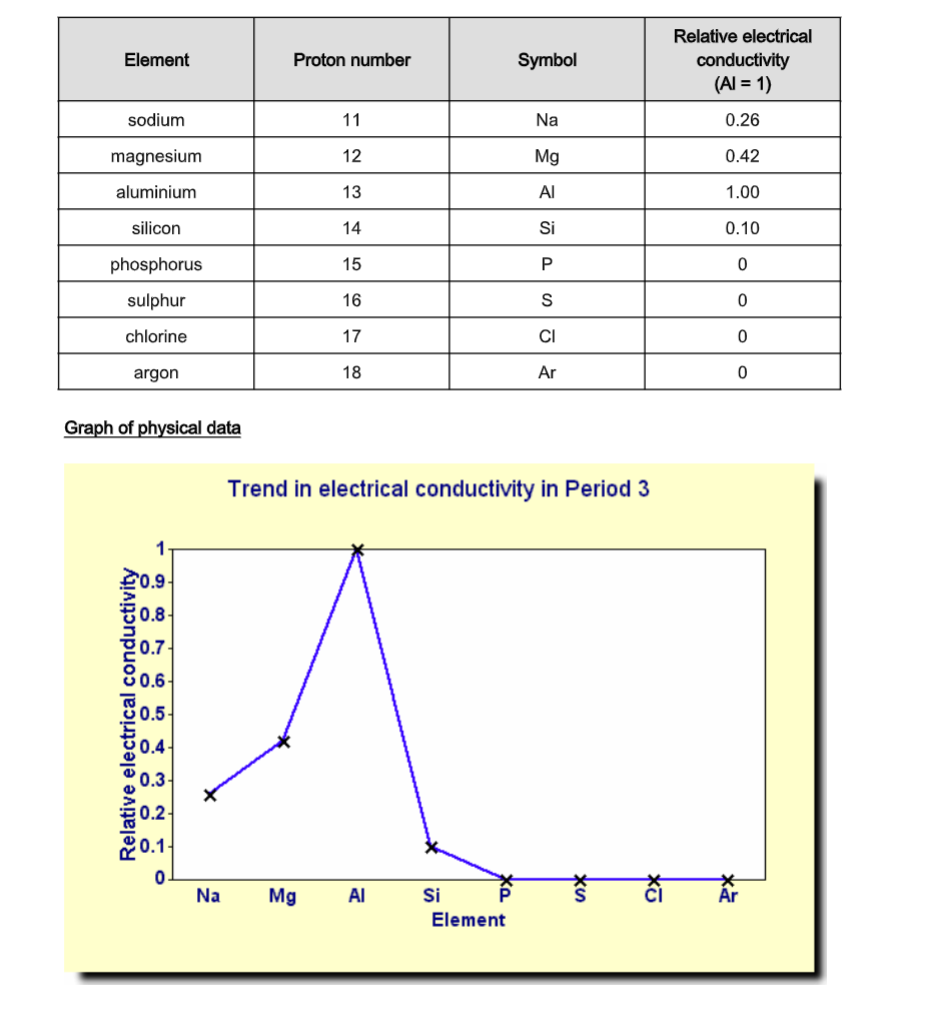
For an element to conduct electricity, it must contain electrons that are free to move.
In general, metals are good conductors of electricity and non-metals are poor conductors of electricity.
Sodium, magnesium and aluminium
Sodium, magnesium and aluminium are all metals.
They have metallic bonding, in which positive metal ions are attracted to delocalised electrons.
The delocalised electrons are free to move and carry charge. Going from sodium to aluminium:
• the number of delocalised electrons increases ...
• there are more electrons which can move and carry charge ...
• So the electrical conductivity increases.
Silicon
Silicon is a metalloid (an element with some of the properties of metals and some of the properties of non-metals).
Silicon has giant covalent bonding. It has a giant lattice structure similar to that of diamond, in which each silicon atom is covalently-bonded to four other silicon atoms in a tetrahedral arrangement.
This extends in three dimensions to form a giant molecule or macromolecule.
Silicon is called a semiconductor because:
• the four outer electrons in each atom are held strongly in covalent bonds ...
• few electrons have enough energy at room temperature to enter the higher energy levels so there are few delocalised electrons and silicon is a poor conductor ... but ...
• at higher temperatures more electrons are promoted to the higher energy levels ...
• so there are more delocalised electrons to move and carry charge.
Non-metals
The remaining elements in Period 3 do not conduct electricity:
• in phosphorus, sulphur and chlorine, the outer electrons are not free to move and carry charge because they are held strongly in covalent bonds ...
• in argon (which exists as single atoms) the outer electrons are not free to move and carry charge because they are held strongly in a stable third energy level.
Trends in melting and boiling points
The trends in melting points and boiling points going across Period 3 are not straightforward, and need more detailed consideration than the trends in Group 2:
• Melting points generally increase going from sodium to silicon, then decrease going to argon (with a “bump” at sulphur).
• Boiling points generally increase going from sodium to aluminium, then decrease to argon (again with a “bump” at sulphur).
Table of physical data
Melting
When a substance melts, some of the attractive forces holding the particles together are broken or loosened so that the particles can move freely around each other but are still close together.
The stronger these forces are, the more energy is needed to overcome them and the higher the melting temperature.
Boiling
When a substance boils, most of the remaining attractive forces are broken so the particles can move freely and far apart.
The stronger the attractive forces are, the more energy is needed to overcome them and the higher the boiling temperature.
Sodium, magnesium and aluminium
Sodium, magnesium and aluminium are all metals.
They have metallic bonding, in which positive metal ions are attracted to delocalised electrons.
Going from sodium to aluminium:
• the charge on the metal ions increases from +1 to +3 (with magnesium at +2) ...
• the number of delocalised electrons increases ...
• so the strength of the metallic bonding increases and ...
• the melting points and boiling points increase.
Silicon
Silicon is a metalloid (an element with some of the properties of metals and some of the properties of non-metals).
Silicon has giant covalent bonding.
It has a giant lattice structure similar to that of diamond, in which each silicon atom is covalently-bonded to four other silicon atoms in a tetrahedral arrangement.
This extends in three dimensions to form a giant molecule or macromolecule.
Silicon has a very high melting point and boiling point because:
• All the silicon atoms are held together by strong covalent bonds ...
• Which need a very large amount of energy to be broken.
Phosphorus, sulphur, chlorine and argon
These are all non-metals, and they exist as small, separate molecules.
Phosphorus, sulphur and chlorine exist as simple molecules, with strong covalent bonds between their atoms.
Argon exists as separate atoms (it is monatomic).
Their melting and boiling points are very low because when these four substances melt or boil, it is the van der Waal’s forces between the molecules which are broken.
These bonds are very weak bonds so little energy is needed to overcome them.
Sulphur has a higher melting point and boiling point than the other three because:
• phosphorus exists as P4 molecules
• sulphur exists as S8 molecules
• chlorine exists as Cl2 molecules
• argon exists individual Ar atoms
• the strength of the van der Waal’s forces decreases as the size of the molecule decreases
• so the melting points and boiling points decrease in the order S8 > P4 > Cl2
> Ar
Summary of the characteristics of elements in a period:
The reactivity on the left extreme is most electro-positive whereas on the extreme right it is most electro-negative.
Oxides of elements in the centre are amphoteric.
Assessment 2
1. In 1829 Dobereiner suggested that some elements could be put into groups of three because they had similar chemical properties.
(a) Use the information in this table to explain why these elements are placed in the same group.
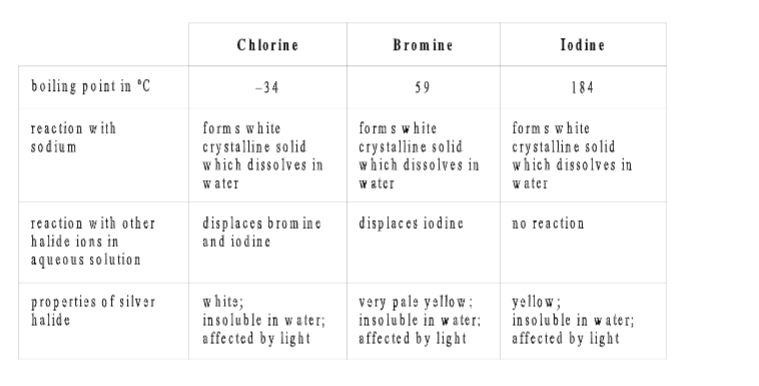
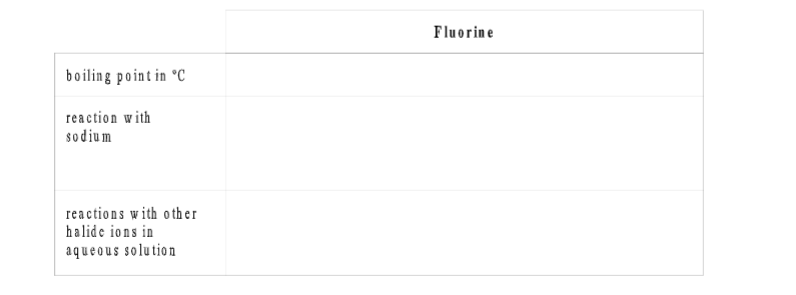
(i) What is the atomic number of R?
(ii) In which group of the periodic table is R found?
(iii) Find R in the periodic table.
Give the name of a more reactive element in the same group as R.
(iv) Although R is a very reactive element, it does not react with krypton, the element immediately before it in the periodic table.Suggest a reason for this failure to react.
3. A small piece of sodium is dropped into a large beaker of water.
It reacts to form sodium hydroxide solution and a gas.
(a) Describe three things you would see in this experiment.
(b) Give the name of the gas formed by this reaction.
(c) Sodium hydroxide solution has a pH of 14.
Complete the sentence using a word from the box.
acidic alkaline neutral
Sodium hydroxide solution is …………………................................……………..
(d) The reaction between sodium and water is exothermic.
How would the temperature of the water change during the reaction?
(c) The experiment was repeated with a piece of potassium of the same size.
Give two observations that would be different in this experiment.
4. Part of the periodic table is shown.
The letters used are not the symbols of the elements.
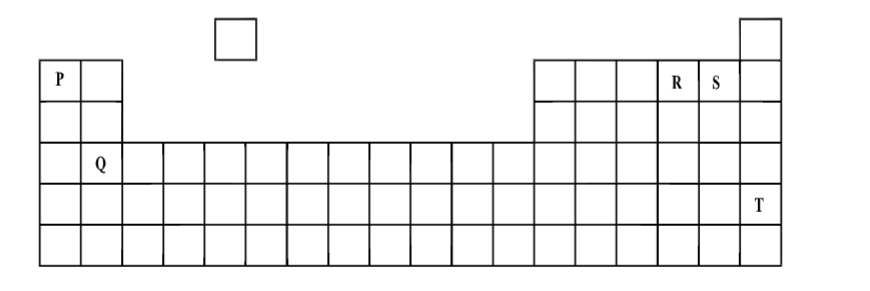
Each letter may be used once, more than once, or not at all.
Give the letter of
(i) a group 7 element
(ii) a group 0 element
(iii) a solid at room temperature
(iv) a metal
(v) a gas at room temperature
7. (a) Noble gases are used in advertising signs and in light bulbs.
(i) Name a noble gas used in one of these ways.
(ii) Explain why it is chosen for this use.
(b) The table gives the boiling points of the noble gases.
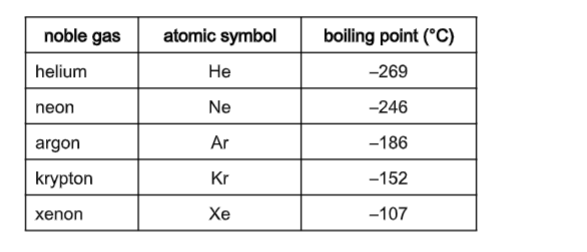

(ii) Using the data, calculate the relative atomic mass of neon.
(iii) Explain why the noble gases are unreactive.
8.0.0. Structure and Bonding
Ionic (Electrovalent) Bonding
Noble gases like neon or argon have eight electrons in their outer shells (or two in the case of helium).
These noble gas structures are thought of as being in some way a "desirable" thing for an atom to have.
When other atoms react, they try to organise electrons such that their outer shells are either completely full or completely empty.
Chemical reactions occur so that atoms attain inert gas configuration by either losing valency electrons as in the case of metals, or gaining electrons as in the case of non metals.
Ionic bonding in sodium chloride
Sodium (2,8,1) has 1 electron more than a stable noble gas structure (2,8). If it gave away that electron it would become more stable.
Chlorine (2,8,7) has 1 electron short of a stable noble gas structure (2,8,8).
If it could gain an electron from somewhere it too would become more stable.
If a sodium atom gives an electron to a chlorine atom, both become more stable.
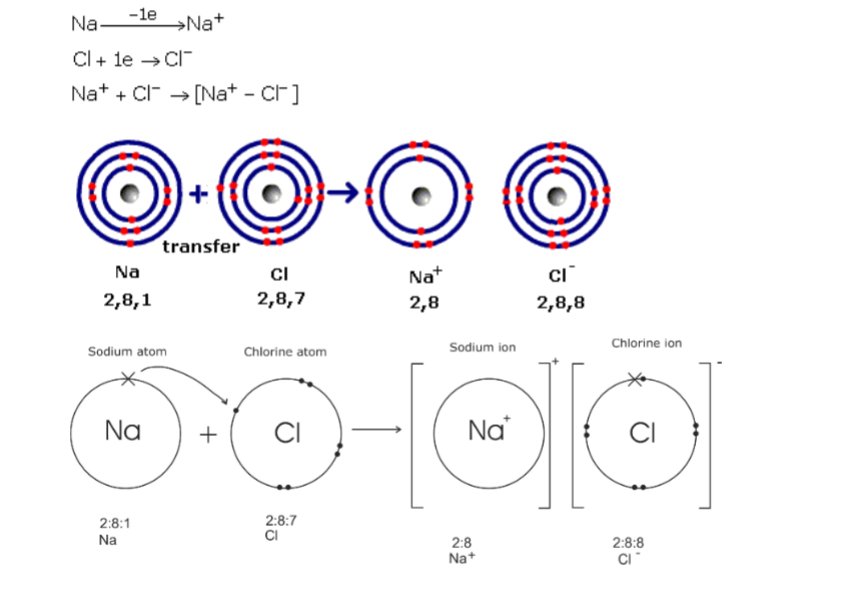
Because it has one more proton than electron, it has a charge of 1+.
If electrons are lost from an atom, positive ions are formed.
Positive ions are sometimes called cations because they move to the cathode during electrolysis.
The chlorine has gained an electron, so it now has one more electron than proton.
It therefore has a charge of 1-.
If electrons are gained by an atom, negative ions are formed.
A negative ion is sometimes called an anion since it drifts to the anode during electrolysis.
The nature of ionic bond
The sodium ions and chloride ions are held together by the strong electrostatic attractions between the positive and negative charges.
You need one sodium atom to provide the extra electron for one chlorine atom, so they combine together 1:1. The formula is therefore NaCl.
Magnesium oxide
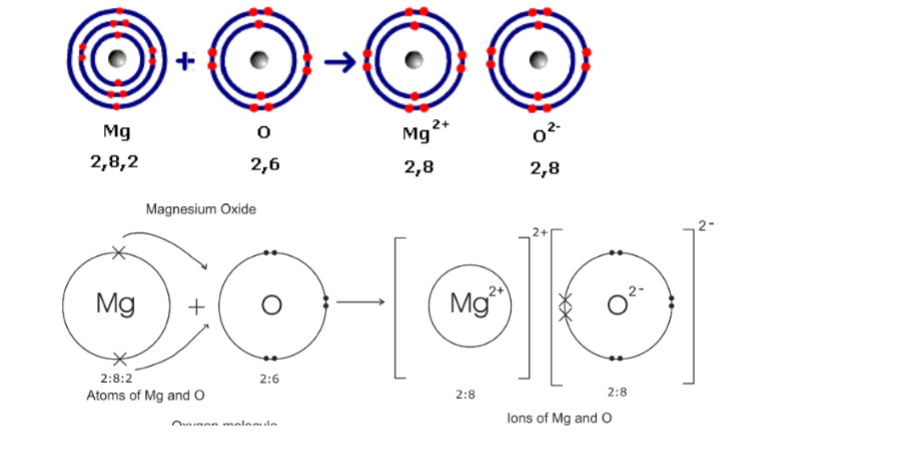
The ionic bonding is stronger than in sodium chloride because this time you have 2+ ions attracting 2- ions.
The greater the charge, the greater the attractive force. The formula of magnesium oxide is MgO.
Summary
• Electrons are transferred from one atom to another resulting in the formation of positive and negative ions.
• The electrostatic attractions between the positive and negative ions hold the compound together.
Properties of ionic compounds
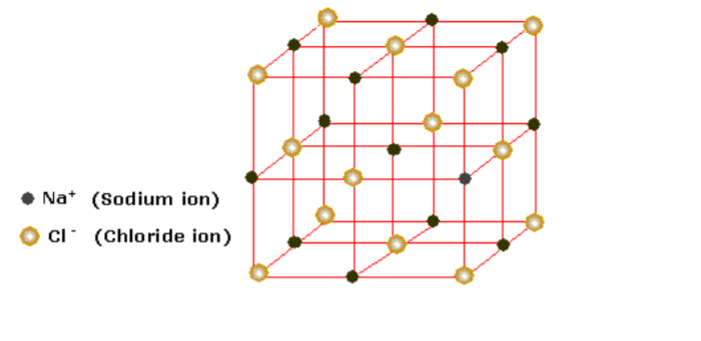
Covalent Bonding - Single Bonds
As well as achieving noble gas structures by transferring electrons from one atom to another as in ionic bonding, it is also possible for atoms to reach these stable structures by sharing electrons to give covalent bonds.
Depending on the number of electron pairs shared between atoms which participate in bonding, covalent bonds are classified as follows:

Chlorine
For example, two chlorine atoms could both achieve stable structures by sharing their single unpaired electron as in the diagram.
The fact that one chlorine has been drawn with electrons marked as crosses and the other as dots is simply to show where all the electrons come from. In reality there is no difference between them.
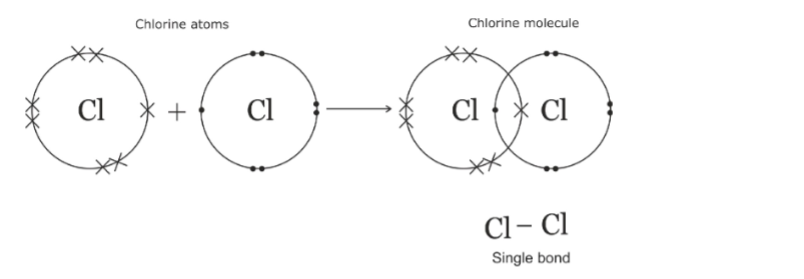
The reason that the two chlorine atoms stick together is that the shared pair of electrons is attracted to the nucleus of both chlorine atoms.
Hydrogen
Hydrogen atoms only need two electrons in their outer level to reach the noble gas structure of helium.

Hydrogen chloride

Water
Oxygen atom has six electrons in the outer shell, while each of the two hydrogen atoms has one each.
After bonding, oxygen has 8 electrons while each hydrogen atom has two as shown by the molecule.
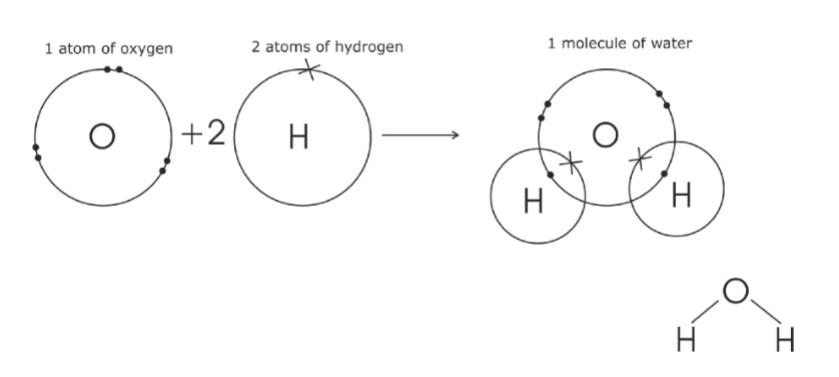
Each nitrogen atom has five electrons in the outer shell. Each needs 3 electrons to complete the outer shell.
In the formation of the molecule, each nitrogen atom contributes three electrons and a triple bond is formed
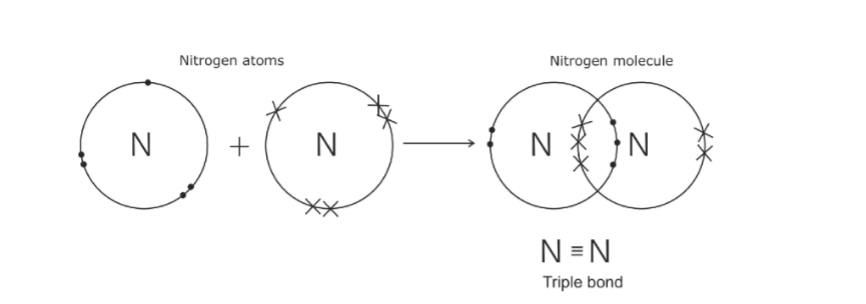
Each oxygen atom has six electrons in the outer shell. Each atom donates two electrons for sharing.
After the covalent double bond is formed, each atom has 8 electrons around it as shown.
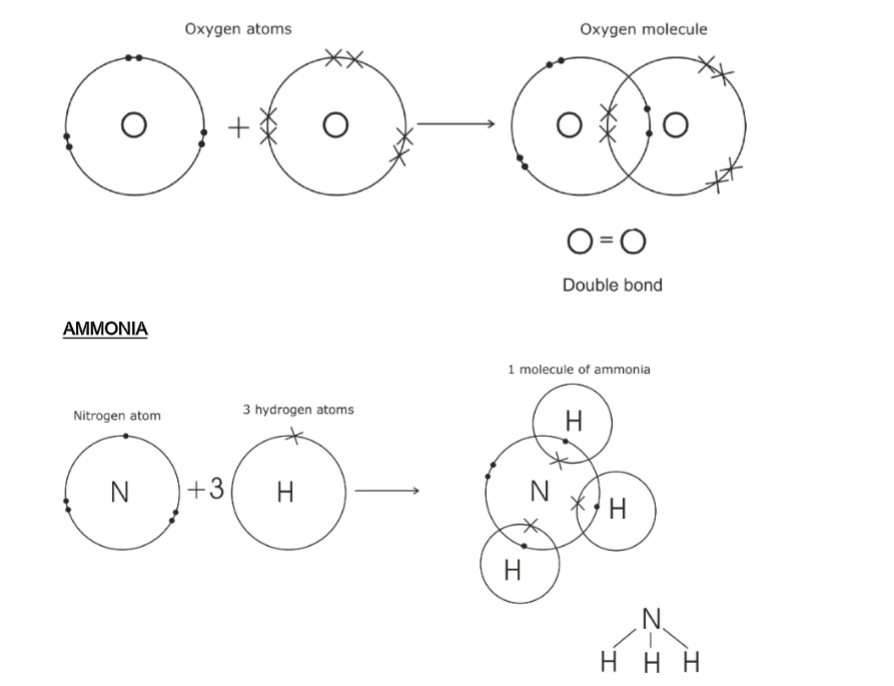
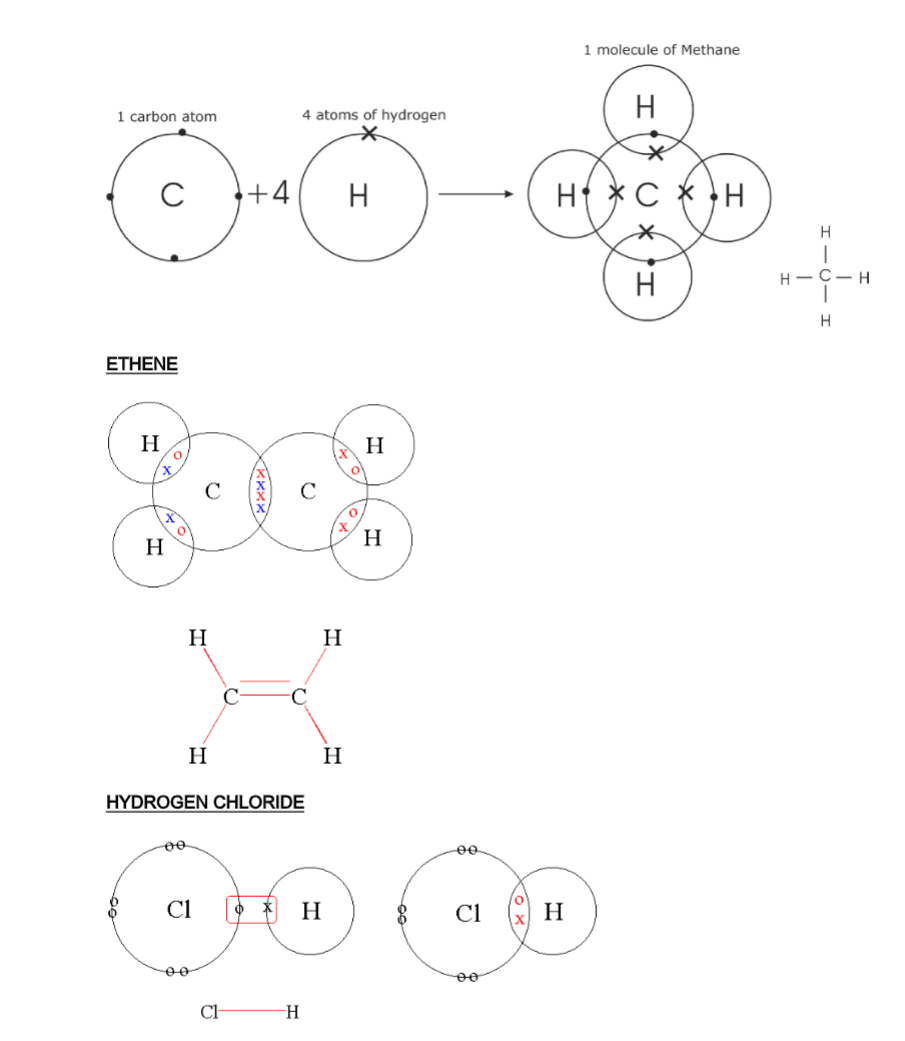

1) Covalent compounds consist of molecules and not ions. The molecules do not have any electric charge on them. The molecules are held together by weak forces called Van der Waal's forces.
2) Covalent compounds are gases, volatile liquids or soft solids. As there are weak, Van der Waal's forces between the molecules, they are not held in rigid position.
The state depends on the bond energy. If the bond energy is very low, they stay as gases, if it is appreciable they are volatile liquids. If very high, they exist as soft solids.
3) Covalent compounds generally have low melting and boiling points.
As Van der Waal's forces are weak, a very small amount of energy is required to break the bond between the molecules corresponding to low melting point and boiling point.
4) Covalent compounds dissolve in organic solvents. As they do not contain ions, solvation does not take place when water is added to the compound. Hence they do not dissolve in water.
5) Covalent compounds are bad conductors of electricity.
They do not contain ions in the fused state, nor do ions migrate on application of an electric potential. Hence, there is no conduction of current.
6) Covalent compounds are less dense when compared to water.
Very weak Van der Waal's forces hold the molecules together, hence there are large inter molecular spaces.
Consequently less number of molecules per unit volume, which means mass per unit volume is also less. Hence they have a low density.
Exceptions
Giant Covalent Structures
The giant covalent structure of diamond Carbon has an electronic arrangement of 2, 4.
In diamond, each carbon shares electrons with four other carbon atoms - forming four single bonds.
In the diagram some carbon atoms only seem to be forming two bonds (or even one bond), but that's not really the case. We are only showing a small bit of the whole structure.
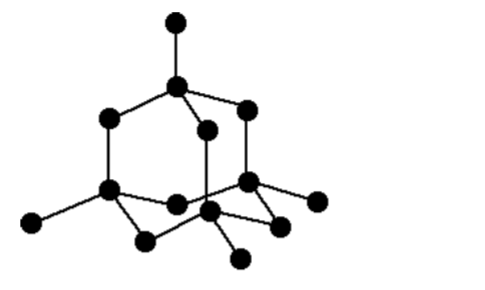
It is not a molecule, because the number of atoms joined up in a real diamond is completely variable - depending on the size of the crystal.
The physical properties of diamond
Diamond
• Has a very high melting point (almost 4000°C).
Very strong carbon-carbon covalent bonds have to be broken throughout the structure before melting occurs.
• Is very hard.
This is again due to the need to break very strong covalent bonds operating in 3-dimensions.
• Doesn’t conduct electricity.
All the electrons are held tightly between the atoms, and aren't free to move.
• Is insoluble in water and organic solvents.
There are no possible attractions which could occur between solvent molecules and carbon atoms which could outweigh the attractions between the covalently bound carbon atoms.
The giant covalent structure of graphite
Graphite has a layer structure which is quite difficult to draw convincingly in three dimensions.
The diagram below shows the arrangement of the atoms in each layer, and the way the layers are spaced.
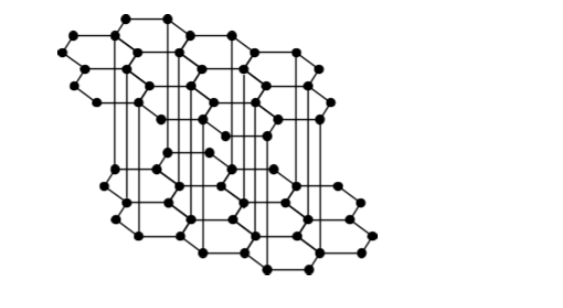
Each carbon atom uses three of its electrons to form simple bonds to its three close neighbours.
That leaves a fourth electron in the bonding level.
These "spare" electrons in each carbon atom become delocalised over the whole of the sheet of atoms in one layer.
They are no longer associated directly with any particular atom or pair of atoms, but are free to wander throughout the whole sheet.
The important thing is that the delocalised electrons are free to move anywhere within the sheet - each electron is no longer fixed to a particular carbon atom.
There is, however, no direct contact between the delocalised electrons in one sheet and those in the neighbouring sheets.
The atoms within a sheet are held together by strong covalent bonds - stronger, in fact, than in diamond because of the additional bonding caused by the delocalised electrons.
So what holds the sheets together?
In graphite you have the ultimate example of van der Waals dispersion forces.
As the delocalised electrons move around in the sheet, very large temporary dipoles can be set up which will induce opposite dipoles in the sheets above and below - and so on throughout the whole graphite crystal.
The physical properties of graphite
Graphite
• Has a high melting point, similar to that of diamond. In order to melt graphite, it isn't enough to loosen one sheet from another.
You have to break the covalent bonding throughout the whole structure.
• Has a soft, slippery feel, and is used in pencils and as a dry lubricant for things like locks.
You can think of graphite rather like a pack of cards - each card is strong, but the cards will slide over each other, or even fall off the pack altogether.
When you use a pencil, sheets are rubbed off and stick to the paper.
• Has a lower density than diamond. This is because of the relatively large amount of space that is "wasted" between the sheets.
• Is insoluble in water and organic solvents - for the same reason that diamond is insoluble.
Attractions between solvent molecules and carbon atoms will never be strong enough to overcome the strong covalent bonds in graphite.
• Conducts electricity. The delocalised electrons are free to move throughout the sheets. If a piece of graphite is connected into a circuit, electrons can fall off one end of the sheet and be replaced with new ones at the other end.
The structure of silicon dioxide, SiO2
Silicon dioxide is also known as silicon (IV) oxide.
The giant covalent structure of silicon dioxide
There are three different crystal forms of silicon dioxide. The easiest one to remember and draw is based on the diamond structure.
Crystalline silicon has the same structure as diamond.
To turn it into silicon dioxide, all you need to do is to modify the silicon structure by including some oxygen atoms.
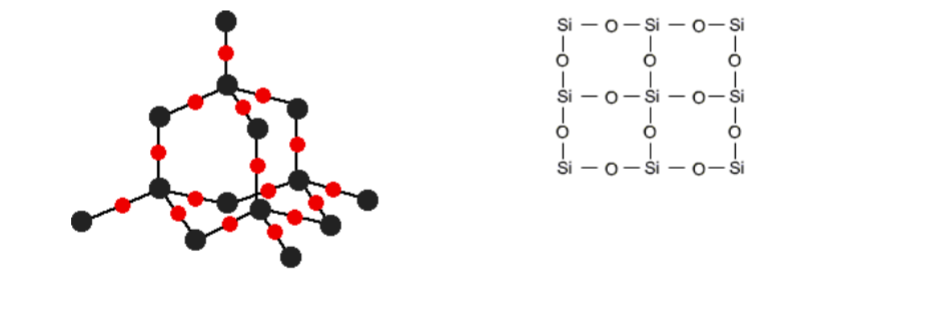
The physical properties of silicon dioxide
Silicon dioxide
• Has a high melting point - varying depending on what the particular structure is (remember that the structure given is only one of three possible structures), but around 1700°C.
Very strong silicon-oxygen covalent bonds have to be broken throughout the structure before melting occurs.
• Is hard. This is due to the need to break the very strong covalent bonds.
• Doesn’t conduct electricity. There aren't any delocalised electrons. All the electrons are held tightly between the atoms, and aren't free to move.
• Is insoluble in water and organic solvents.
There are no possible attractions which could occur between solvent molecules and the silicon or oxygen atoms which could overcome the covalent bonds in the giant structure.
Uses of Silica
i) Quartz glass is used for manufacturing optical instruments.
ii) Colored quartz is used for manufacturing gems.
iii) Sand is used in manufacture of glass, porcelain, sand paper and mortar etc.
iv) Sand stone is used as a building material.
Co-ordinate (Dative Covalent) Bonding
Co-ordinate (dative covalent) bonding
A covalent bond is formed by two atoms sharing a pair of electrons.
The atoms are held together because the electron pair is attracted by both of the nuclei.
In the formation of a simple covalent bond, each atom supplies one electron to the bond - but that doesn't have to be the case.
A co-ordinate bond (also called a dative covalent bond) is a covalent bond (a shared pair of electrons) in which both electrons come from the same atom.
The reaction between ammonia and hydrogen chloride
If these colourless gases are allowed to mix, a thick white smoke of solid ammonium chloride is formed. Ammonium ions, NH4+, are formed by the transfer of a hydrogen ion from the hydrogen chloride to the lone pair of electrons on the ammonia molecule.
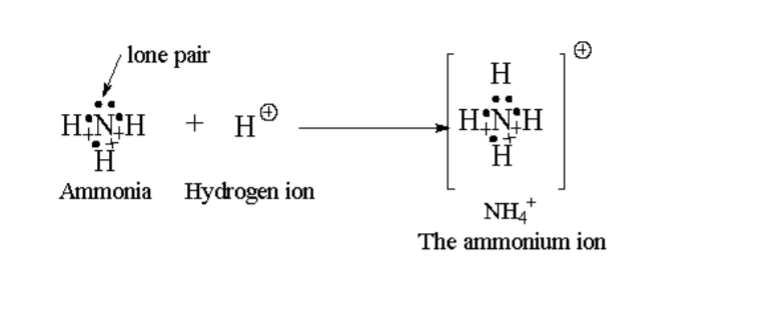
The hydrogen's electron is left behind on the chlorine to form a negative chloride ion.
Once the ammonium ion has been formed it is impossible to tell any difference between the dative covalent and the ordinary covalent bonds.
Although the electrons are shown differently in the diagram, there is no difference between them in reality.
Intermolecular Bonding - Van Der Waals Forces
(a) Van Der Waals Forces
Intermolecular attractions are attractions between one molecule and a neighbouring molecule.
The forces of attraction which hold an individual molecule together (for example, the covalent bonds) are known as intramolecular attractions.
All molecules experience intermolecular attractions, although in some cases those attractions are very weak.
Even in a gas like hydrogen, H2, if you slow the molecules down by cooling the gas, the attractions are large enough for the molecules to stick together eventually to form a liquid and then a solid.
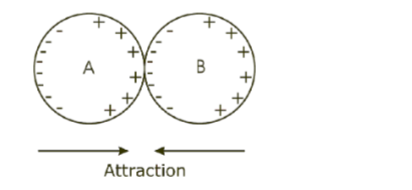
Helium's intermolecular attractions are even weaker - the molecules won't stick together to form a liquid until the temperature drops to (-269°C).
Hydrogen Bonding
Polar molecules, such as water molecules, have a weak, partial negative charge at one region of the molecule (the oxygen atom in water) and a partial positive charge elsewhere (the hydrogen atoms in water).
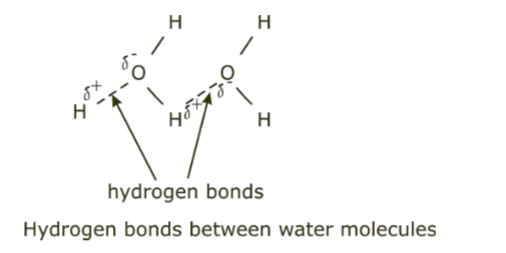
The force of attraction, shown here as a dotted line, is called a hydrogen bond. Each water molecule is hydrogen bonded to four others.
The hydrogen bonds that form between water molecules account for some of the essential — and unique — properties of water.
• The attraction created by hydrogen bonds keeps water liquid over a wider range of temperature than is found for any other molecule its size.
• The energy required to break multiple hydrogen bonds causes water to have a high heat of vaporization; that is; a large amount of energy is needed to convert liquid water, where the molecules are attracted through their hydrogen bonds, to water vapor, where they are not.
Liquid Water and Hydrogen Bonding
Why water is a liquid?
In many ways, water is a miracle liquid. Since the hydrogen and oxygen atoms in the molecule carry opposite (though partial) charges, nearby water molecules are attracted to each other like tiny little magnets.
Hydrogen bonding makes water molecules "stick" together.
This makes water have high melting and boiling points compared to other covalent compounds such as ammonia (NH3) which have similar molecular mass but are gases
Ice and Hydrogen Bonding
The structure that forms in the solid ice crystal actually has large holes in it.
Therefore, in a given volume of ice, there are fewer water molecules than in the same volume of liquid water.
In other words, ice is less dense than liquid water and will float on the surface of the liquid.
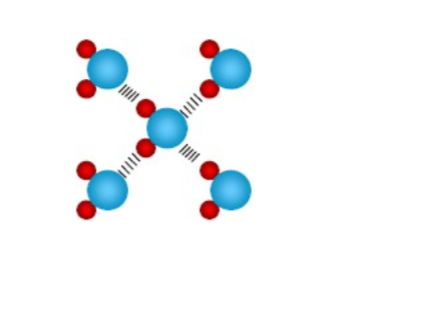
As we just discussed, neighboring water molecules are attracted to one another.
Molecules at the surface of liquid water have fewer neighbors and, as a result, have a greater attraction to the few water molecules that are nearby.
This enhanced attraction is called surface tension.
It makes the surface of the liquid slightly more difficult to break through than the interior.
Water as a Solvent
The partial charge that develops across the water molecule helps make it an excellent solvent.
Water dissolves many substances by surrounding charged particles and "pulling" them into solution.
For example, common table salt, sodium chloride, is an ionic substance that contains alternating sodium and chlorine ions.
When table salt is added to water, the partial charges on the water molecule are attracted to the Na+ and Cl- ions.

Ethanol, CH3CH2-O-H, and methoxymethane, CH3-O-CH3, both have the same molecular formula, C2H6O.
They have the same number of electrons, and a similar length to the molecule.
The van der Waals attractions (both dispersion forces and dipole-dipole attractions) in each will be much the same.
However, ethanol has a hydrogen atom attached directly to oxygen - and that oxygen still has exactly the same two lone pairs as in a water molecule.
Hydrogen bonding can occur between ethanol molecules, although not as effectively as in water.
The hydrogen bonding is limited by the fact that there is only one hydrogen in each ethanol molecule with sufficient + charge.
In methoxymethane, the lone pairs on the oxygen are still there, but the hydrogens aren't sufficiently + for hydrogen bonds to form.
Except in some rather unusual cases, the hydrogen atom has to be attached directly to the very electronegative element for hydrogen bonding to occur.
The boiling points of ethanol and methoxymethane show the dramatic effect that the hydrogen bonding has on the stickiness of the ethanol molecules:
ethanol (with hydrogen bonding) 78.5°C methoxymethane (without hydrogen bonding) -24.8°C The hydrogen bonding in the ethanol has lifted its boiling point about 100°C.
It is important to realise that hydrogen bonding exists in addition to van der Waals attractions.
For example, all the following molecules contain the same number of electrons, and the first two are much the same length.
The higher boiling point of the butan-1-ol is due to the additional hydrogen bonding.
4. Bonding in Metals
Bonding in metals
Metal atoms have relatively few electrons in their outer shells. When they are packed together, each metal atom loses its outer electrons into a ‘sea’ of free electrons (or mobile electrons).
Having lost electrons, the atoms are no longer electrically neutral.
They become positive ions because they have lost electrons but the number of protons in the nucleus has remained unchanged.
Therefore the structure of a metal is made up of positive ions packed together.
These ions are surrounded by electrons, which can move freely between the ions.
These free electrons are delocalized (not restricted to orbiting one positive ion) and form a kind of electrostatic ‘glue’ holding the structure together.
In an electrical circuit, metals can conduct electricity because the mobile electrons can move through the structure carrying charge.
His type of bonding (called metallic boding) is present in alloys as well. Alloys, for example solder and brass, will conduct electricity.
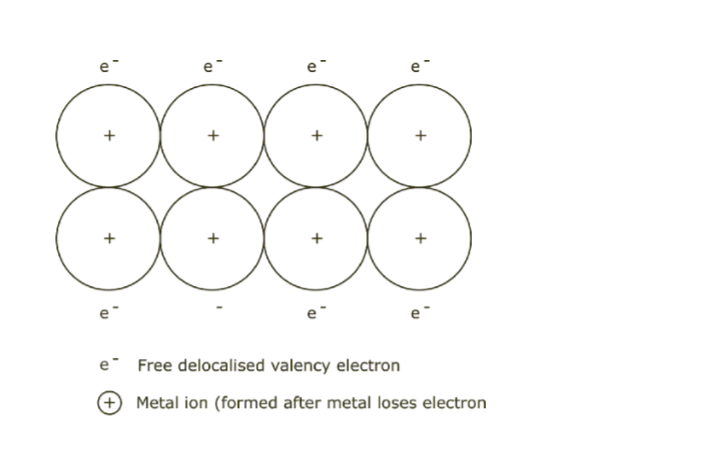
This strong bonding generally results in dense, strong materials with high melting and boiling points.
Usually a relatively large amount of energy is needed to melt or boil metals.
a. Metals are good conductors of electricity because these 'free' electrons carry the charge of an electric current when a potential difference (voltage!) is applied across a piece of metal.
b. Metals are also good conductors of heat. This is also due to the free moving electrons.
Non-metallic solids conduct heat energy by hotter more strongly vibrating atoms, knocking against cooler less strongly vibrating atoms to pass the particle kinetic energy on.
In metals, as well as this effect, the 'hot' high kinetic energy electrons move around freely to transfer the particle kinetic energy more efficiently to 'cooler' atoms.
c. Typical metals also have a silvery surface but remember this may be easily tarnished by corrosive oxidation in air and water.
d. Unlike ionic solids, metals are very malleable, they can be readily bent, pressed or hammered into shape.
Assesment 3
1. The table shows some properties of diamond and graphite.

colorless, transparent crystals black shiny solid
hardest natural substance known flakes easily
non-conductor of electricity conductor of electricity
(a) Why might you expect diamond and graphite to have the same properties?
(b) Explain why diamond and graphite do not have the same properties.
(c) Explain why diamond does not conduct electricity but graphite does.
(d) Write a balanced equation, including state symbols, for the reaction which occurs when graphite burns in excess air.
2. Carbon dioxide, CO2, and silicon dioxide, SiO2, both occur widely in nature.
(a) (i) In what way are the electron arrangements of a carbon atom and a silicon atom the same?
(ii) Suggest why carbon dioxide and silicon dioxide have some similar properties.
(b) (i) Suggest the type of bonding present in carbon dioxide and silicon dioxide. Give a reason for your answer.
(ii) Suggest the type of structure present in silicon dioxide.
. Give a reason for your answer.
(iii) Describe the structure of solid carbon dioxide.
3. A hydrogen chloride molecule, HCl, is covalent.
(a) (i) Draw a dot and cross diagram of one molecule of hydrogen chloride.
Show the outer electrons only.
(ii) Explain why liquid hydrogen chloride has a low boiling point.
(b) When dissolved in water, hydrogen chloride forms hydrogen ions (H+) and chloride ions (Cl–).
(i) Draw a diagram of a chloride ion, showing the outer electrons only.
(ii) Electrolysis of this solution produces hydrogen.
Write the equation showing the formation of hydrogen from hydrogen ions.
4. The formula for a molecule of water is H2O.
(a) How many atoms are there in one molecule of water?
(b) Draw a dot and cross diagram to show the arrangement of outer shell electrons in one molecule of water. What type of bond is present in water molecules?
5. (a) The dot and cross diagrams show how a sodium atom bonds with a chlorine atom to form sodium chloride.

Compounds with ionic bonding usually have high melting points.
(i) What do the dots and crosses in the diagrams represent?
(ii) What is the name of the negative ion present in sodium chloride?
(iii) What does the high melting point of sodium chloride suggest about the strength of the ionic bonds in sodium chloride?
(b) Two chlorine atoms can bond together as shown in the diagram below.
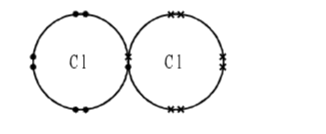
Describe how a covalent bond is formed between two chlorine atoms.
(c) Hydrogen bonds with chlorine to form the compound hydrogen chloride, HCl.
(i) Suggest the type of bonding present in hydrogen chloride.
Give a reason for your answer.
(ii) The relative atomic mass of hydrogen is 1.0.
Use the periodic table to find the relative atomic mass of chlorine.
9.0.0 Salts
General Preparation of Salts
Salts are generally ionic compounds formed by the reaction of an acid with a base.
The preparation of these salts involves the treating of different metals and non-metals and their compounds with various acids, bases etc.
However, some of them can be prepared by direct combination of the concerned elements or also by indirect routes.
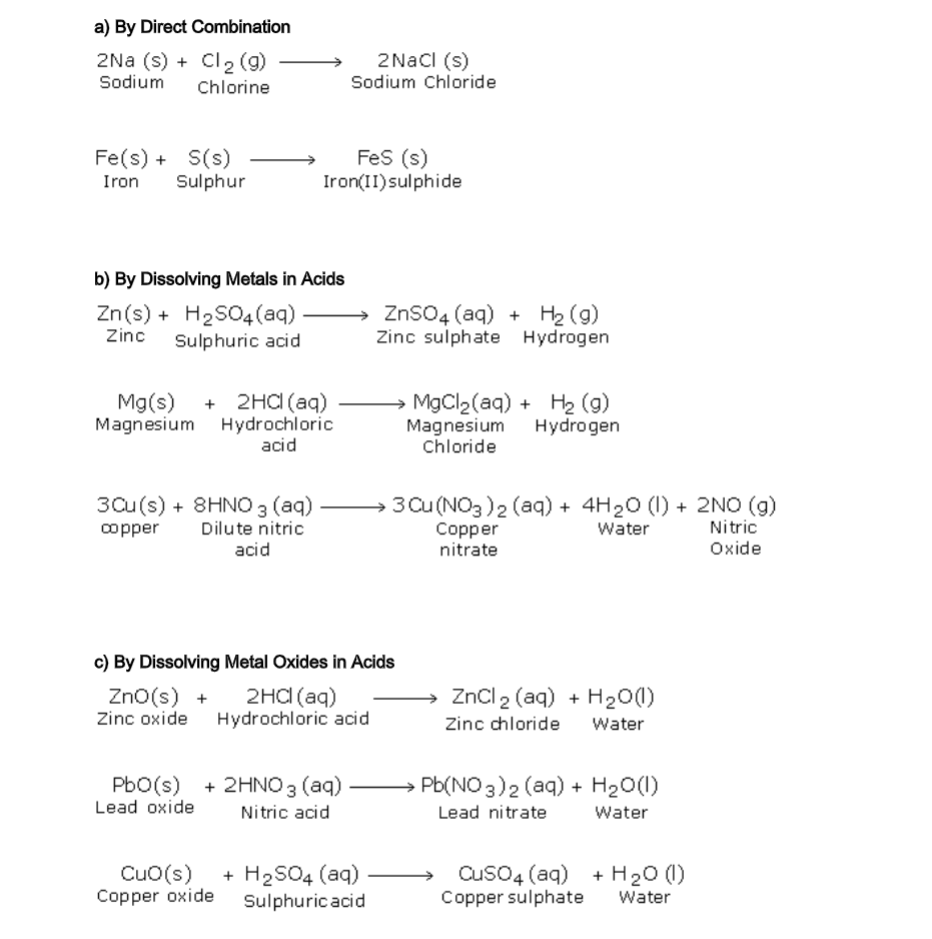
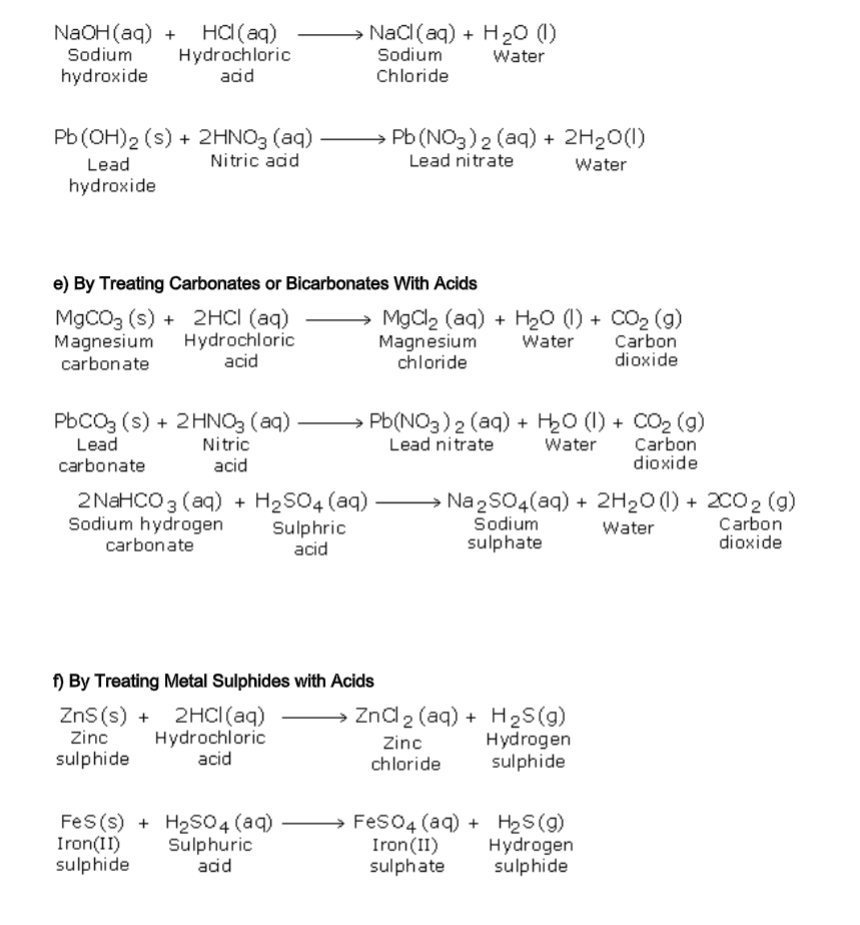
Precipitation is the reaction in which a solid is formed by the action between two or more fluids, e.g., calcium carbonate is precipitated when carbon dioxide is passed through limewater.
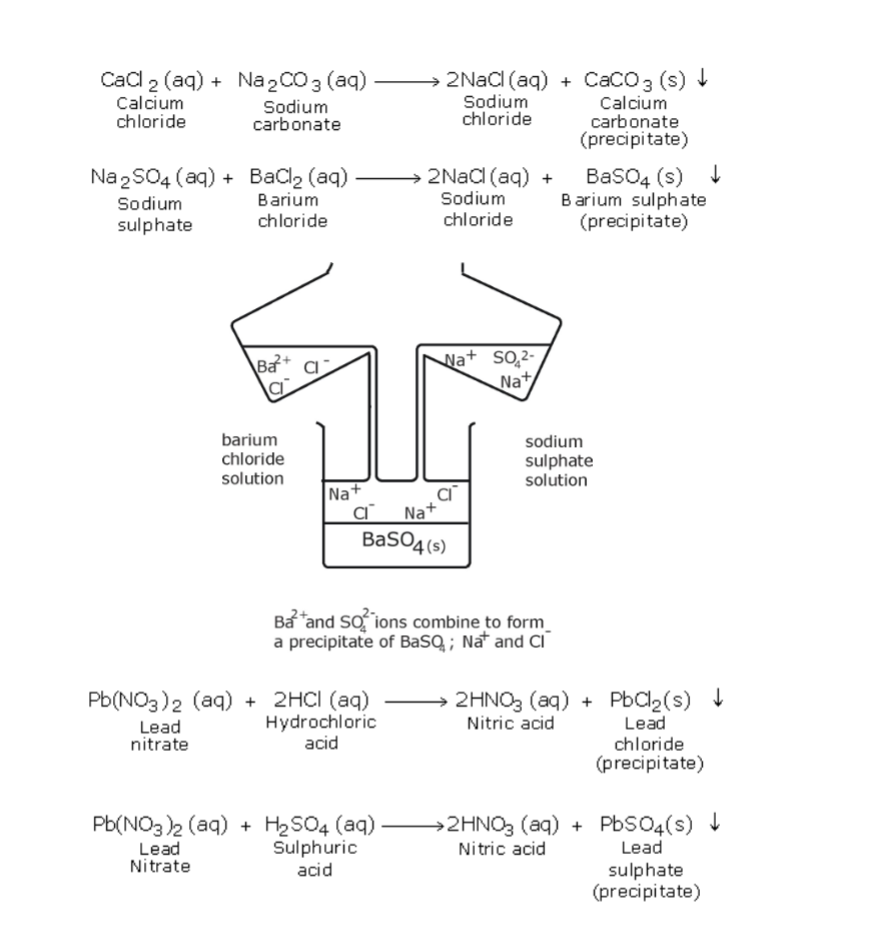
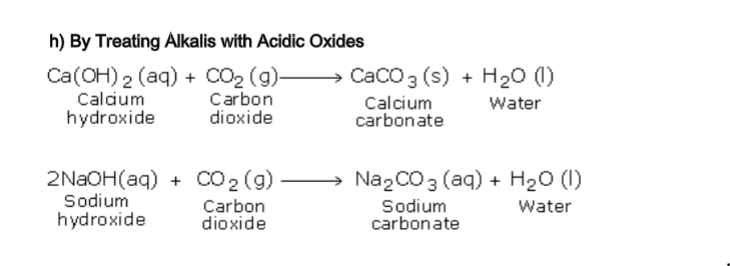
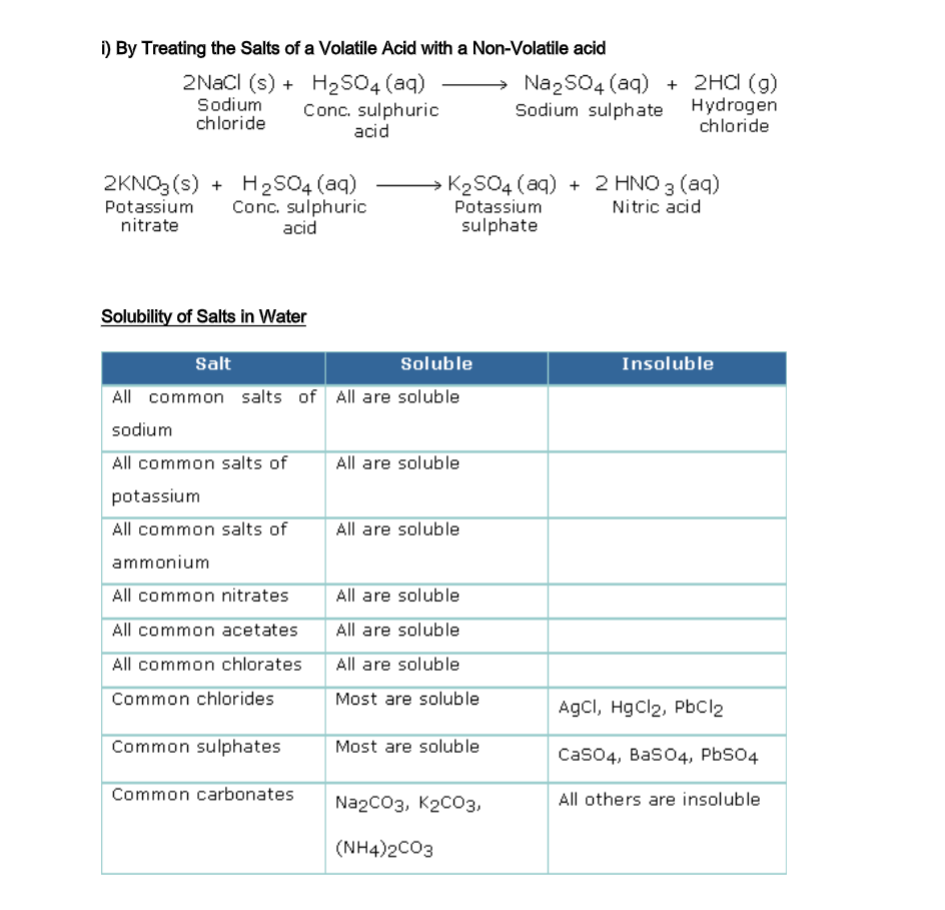
1. (a) A solution of zinc chloride can be prepared by adding excess zinc carbonate to dilute hydrochloric acid.
At the end of the reaction, the remaining zinc carbonate is removed by filtration.
(i) Explain why excess zinc carbonate is used.
(ii) State ONE other zinc compound which reacts with dilute hydrochloric acid to form zinc chloride solution.
(b) Silver chloride can be made by reacting silver nitrate solution with hydrochloric acid.
(i) Write the ionic equation, including state symbols, for this reaction.
(ii) Explain why pure silver chloride could NOT be made by adding silver carbonate to hydrochloric acid.
3. Two students made the insoluble salt, lead sulphate, and wrote these notes about the experiment.
‘We took 25 cm3 of lead nitrate solution and slowly added 25cm3 of acid to it.
The mixture turned cloudy white. We stirred the mixture and filtered it to obtain the solid lead sulphate.’
(a) Describe one safety precaution which the students should take during this experiment.
(b) (i) Which acid was added to lead nitrate solution to make lead sulphate?
(ii) Draw, and name, the piece of apparatus that should be used to measure 25 cm3 of the acid.
3. Lead chloride can be prepared from dilute hydrochloric acid and lead nitrate solution.
The steps to be used are listed below.
They are not in the correct order.
A Filter the mixture.
B Measure out 25 cm3 dilute hydrochloric acid and 25 cm3 lead nitrate solution.
C Wash the lead chloride with distilled water.
D Mix the dilute hydrochloric acid with lead nitrate solution.
E Dry the lead chloride.
(a) Put the steps in the correct order, using the letters, A, B, C, D and E.
(b) (i) What can be used to measure 25 cm3 of dilute hydrochloric acid?
(ii) What safety precaution should be taken when measuring out the acid?
(c) When dilute hydrochloric acid is mixed with lead nitrate solution, lead chloride forms.
The lead chloride forms as a solid because it does not dissolve in water.
What is the general name for any solid formed by mixing solutions?
(d) Name two pieces of apparatus required to filter the mixture.
(e) How can the wet solid lead chloride be dried?
4. Table salt contains sodium chloride. ‘Lo-salt’ is an alternative to table salt. It contains potassium chloride.
(a) (i) What element is found in both sodium chloride and potassium chloride?
(ii) Give the symbol for an atom of this element.
(b) (i) In which group of the periodic table is sodium found?
(ii) In which group of the periodic table is potassium found?
(iii) Why would you expect sodium chloride and potassium chloride to have similar properties?
(c) Potassium chloride is soluble in water.
What do you see when a small amount of solid potassium chloride is stirred in a large volume of water?
10.0.0 Effect of an Electric Current on Substances
Introduction
In any chemical reaction, the existing chemical bonds are broken and new chemical bonds are formed.
Hence, all chemical reactions are fundamentally electrical in nature since electrons are involved in some way or the other in all types of chemical bonding.
Many chemical reactions utilize electrical energy, whereas others can be used to produce electrical energy.
As electrical energy involves the flow of electrons, these reactions are concerned with the transfer of electrons from one substance to the other.
Conductors and insulators
The ability to conduct electricity is the major simple distinction between elements that are metals and non-metals.
1. Conductors
A conductor is a material that conducts electricity but is not chemically changed in the process.
All metals and graphite are conductors of electricity.
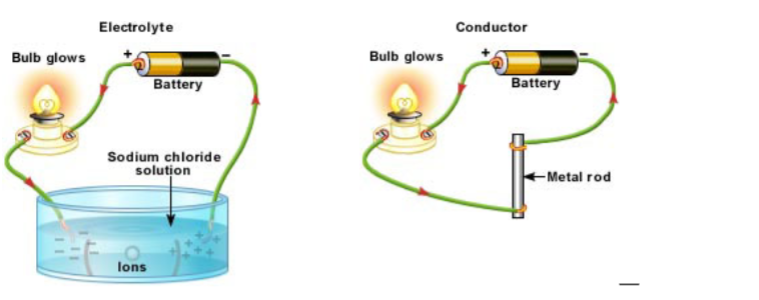
An insulator is a material that does not conduct electricity. Such materials have no free electrons.
Summary of Common Electrical Conductors
These materials carry an electric current via freely moving electrically charged particles, when a potential difference (voltage) is applied across them, and they include:
1) All metals (molten or solid) and the non-metal carbon (graphite).
This conduction involves the movement of free or delocalised electrons (e- charged particles) and does not involve any chemical change.
2) Any molten or dissolved material in which the liquid contains free moving ions is called the electrolyte.
Ions are charged particles e.g. Na+ sodium ion, or Cl- chloride ion, and their movement or flow constitutes an electric current, because a current is moving charged particles.
The movement of opposite charges during electrolysis is due to the attracting in the electric field produced by the potential difference (the voltage).
Liquids that conduct must contain freely moving ions to carry the current and complete the circuit.
You can't do electrolysis with an ionic solid! The ions are too tightly held by chemical bonds and can't flow from their ordered situation! When ionically bonded substances are melted or dissolved in water the ions are free to move about.
However some covalent substances dissolve in water and form ions. e.g. hydrogen chloride HCl, dissolves in water to form 'ionic' hydrochloric acid H+Cl-(aq).
Electrolytes and Non-electrolytes
However, if the compound is unable to ionise it does not conduct electricity it is called a non-electrolyte.
In general, the extent to which an electrolyte can break up into ions categorises an electrolyte.
This gives a measure of the degree of dissociation (a) of an electrolyte.
Based on this degree the electrolytes can be classified as strong or weak electrolyte and non-electrolyte.
Strong Electrolyte
A strong electrolyte, such as a solution of sodium chloride dissociates or ionises completely or almost completely to form free mobile ions in the solution or molten form.
The more the availability of free mobile ions in an electrolyte, the greater is its capacity to carry or conduct current i.e. the stronger the electrolyte.
The ability to conduct current can be observed by setting up a cell as shown in figure 4.4.
The bulb glows brightly.
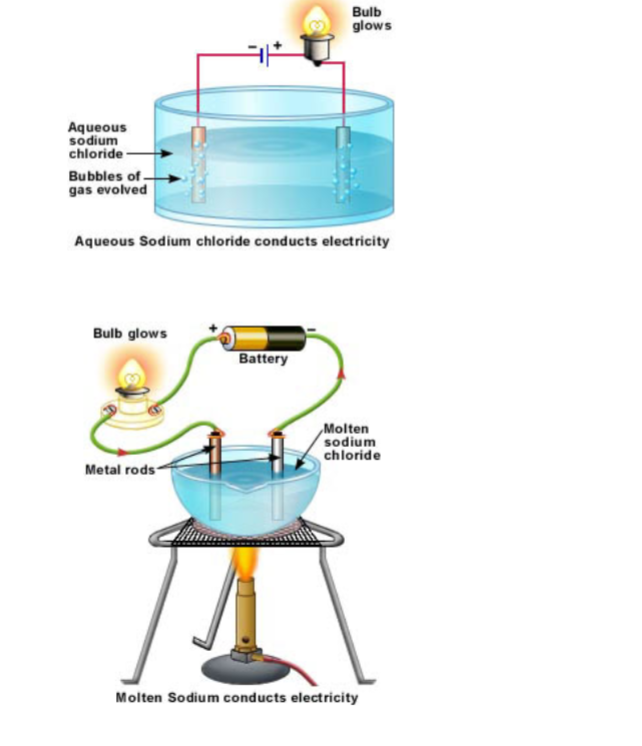
But the ions are not mobile so it does not conduct electricity and the bulb does not light.
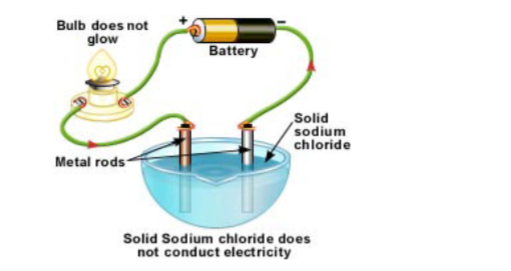
Pure sulphuric acid exists mostly in the form of molecules.
But when mixed with water, it almost completely breaks up into free mobile ions.
Weak Electrolyte
A weak electrolyte ionises or dissociates only partially to form free mobile ions.
Most of the electrolyte remains as un-ionised molecules.
For example in acetic acid, the number of its dissociated ions (the acetate and hydrogen ions) is less compared to the total amount of acetic acid molecules present.
Similarly in ammonium hydroxide the number of its dissociated ions (the ammonium and hydroxyl ions) are less compared to the total amount of the molecules present.

When the number of mobile ions is less in an electrolyte, the lesser is its capacity to carry or conduct current i.e. the weaker is the electrolyte.
This is observed by setting up the cell as shown in figure 4.5. The bulb glows less brightly.
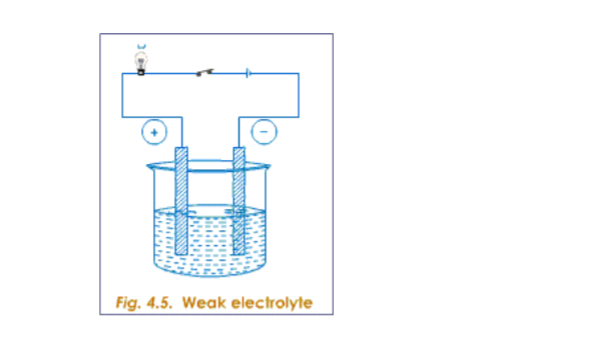
Non-electrolyte
A non-electrolyte does not provide ions in a solution and therefore current does not flow through such solution.
The bulb in the given set up does not glow (Fig.4.6).
Some examples of non-electrolytes are: alcohol, carbon tetrachloride, carbon disulphide.
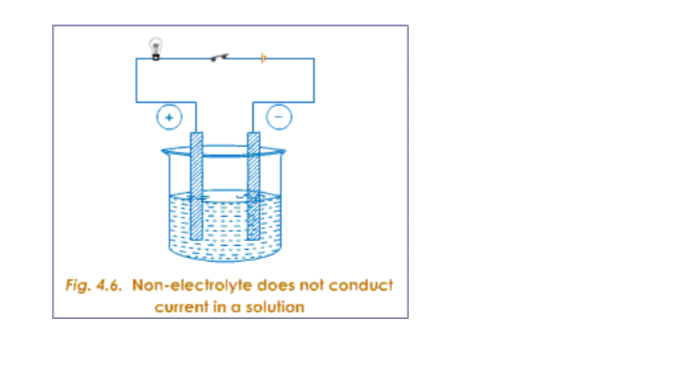
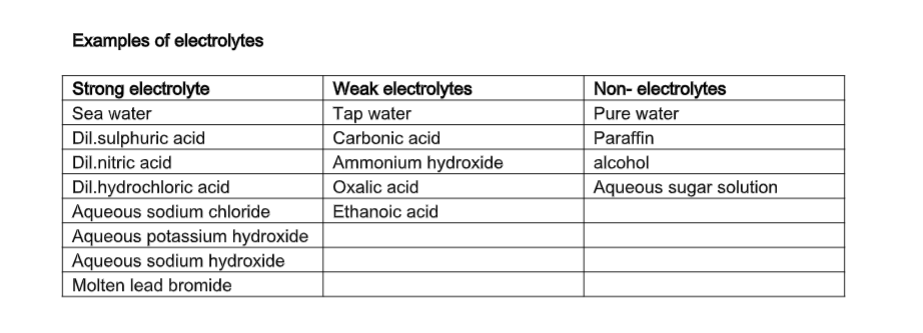
The process of conversion of a neutral atom into charged ions to complete its octet is known as ionization.
In this process, the neutral atom loses or gains electrons.
The particle that loses electrons gains positive charge equal to the number of electrons lost, while the particle that gains electrons gains negative charge equal to the number of electrons gained.
When atoms from metallic elements combine with those from non-metals, they do so by transfer of electrons from one atom to another, forming compounds having "ionic or electrovalent" bonds.
The neutral atom that loses an electron becomes a cation and the neutral atom that acquires an electron becomes an anion.
For e.g., when a sodium atom combines with a chlorine atom to form sodium chloride, the sodium atom loses one electron and becomes positively charged ion.
The chlorine atom gains the electron and it becomes negatively charged ion.
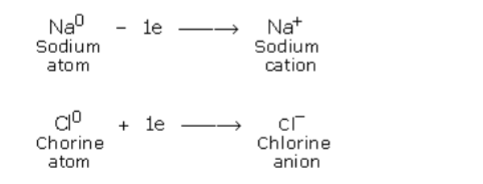
Electrovalent substances are made up of ions in the solid state.
The oppositely charged ions are held together by strong electrostatic force of attraction.
Due to these forces the ions cannot move.
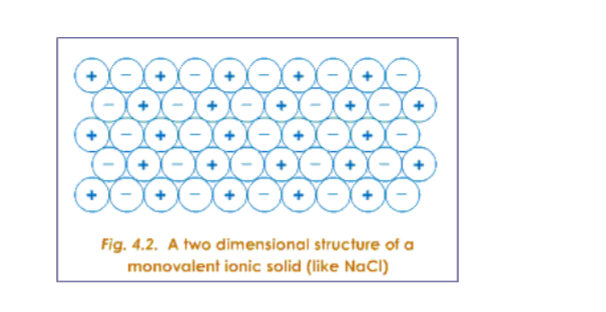
Thus the break up of an electrovalent compound into free mobile ions when dissolved in water or when melted, is called electrolytic dissociation
Theory of Electrolytic Dissociation
The main ideas of the ionic theory or theory of electrolytic dissociation are as follows:
The energy associated with moving charges is called current or electricity.
The flow of electricity is due to the flow of the ions.
Electrolysis Splits a Compound:
When substances which are made of ions are dissolved in water, or melted material, they can be broken down (decomposed) into simpler substances by passing an electric current through them.
This process is called electrolysis.
Since it requires an 'input' of energy, it is an endothermic process.
During electrolysis:
They are known as cations because they drift towards the cathode.
They are known as anions because they drift towards the anode.
In the electrolyte (solution or melt of free moving ions), Positive metal or hydrogen ions move to the negative electrode (cations attracted to cathode), e.g. in the diagram, sodium ions Na+, move to the -ve electrode, and negatively charged ions move to the positive electrode (anions attracted to anode), e.g. in the diagram, chloride ions Cl-, move to the +ve electrode.
During electrolysis, gases may be given off, or metals dissolve or are deposited at the electrodes.
In summary, the following substances are electrolytes:
Metallic conductivity:
Electrolytic conductivity:
Electrolysis Circuit
There are two ion movements in the electrolyte flowing in opposite directions.
Positive cations e.g. Na+ attracted to the negative cathode electrode. Negative anions e.g. Cl- attracted to the positive anode electrode.
No electrons flow in the solution.
They only flow in metal wires or carbon (graphite) electrodes of the external circuit.
The molten or dissolved materials (electrolytes) are usually acids, alkalis or salts and their electrical conduction is usually accompanied by chemical changes e.g. decomposition.
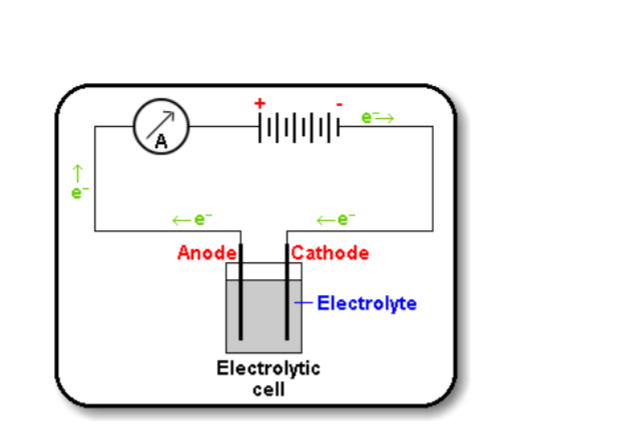
Electrolysis can’t be performed with an ionic solid.
This is because the ions are too tightly held by chemical bonds and can't flow.
When ionically bonded substances are melted or dissolved in water, the ions are free to move about.
However some covalent substances dissolve in water and form ions. Hydrogen chloride (HCl) is covalent.
However it dissolves in water to form 'ionic' hydrochloric acid H+Cl-(aq)
Electrode Reactions
Cathode reactions (reduction)
(-) negative cathode where reduction of the attracted positive cations is by electron gain (reduction) to form metal atoms or hydrogen [from Mn+ or H+, n = numerical charge].
The electrons come from the positive anode.
Hydrogen ions are reduced to hydrogen gas molecules.
Electrolysis of many dilute salts or acid solutions make hydrogen gas by reduction as shown.
2H+(aq) + 2e- H2(g)
Copper (II) ions are reduced to copper atoms in the electrolytic purification or electroplating using copper (II) sulphate solution.
Cu2+(aq) + 2e- Cu(s)
Silver ions reduced to silver atoms in silver electroplating
Ag+(aq) + e- Ag(s)
Anode reactions (oxidation)
Positive anode is where the oxidation of the atom or anion is by electron loss. Non-metallic negative anions are attracted and may be oxidised to the free element.
For example, in the electrolysis of molten chloride salts or their concentrated aqueous solution or conc. hydrochloric acid ,chloride ion oxidised to chlorine gas molecules.
2Cl-(l/aq) Cl2(g) + 2e- In the electrolysis of molten oxides eg anode reaction in the extraction of aluminium from molten bauxite, oxide ion oxidised to oxygen gas molecules. 2O2-(l) O2(g) + 4e- The electrons released by this process travel round the circuit and are donated to the cations (reduction).
Electrolysis of many salt solutions such as sulphates, sulphuric acid etc. gives oxygen.
Hydroxide ions oxidised to oxygen gas molecules.
4OH-(aq) 2H2O(l) + O2(g) + 4e-
Factors That Determine Products of Electrolysis
The ions that are successfully released (or discharged) at the electrodes depend on three factors:
1. The position of the ion in the electrochemical series
2. The concentration of the ion in the solution
3. The nature of the electrode
1. The position of the ion in the electrochemical series
This is probably better expressed as the position of the ions in the electrochemical series.
The ions that are lower in the electrochemical series get discharged in preference to the ones above them.
For e.g., if a solution has potassium ions and copper ions, the copper ions will accept electrons, and get discharged as copper atoms first. The potassium ions will not be affected.
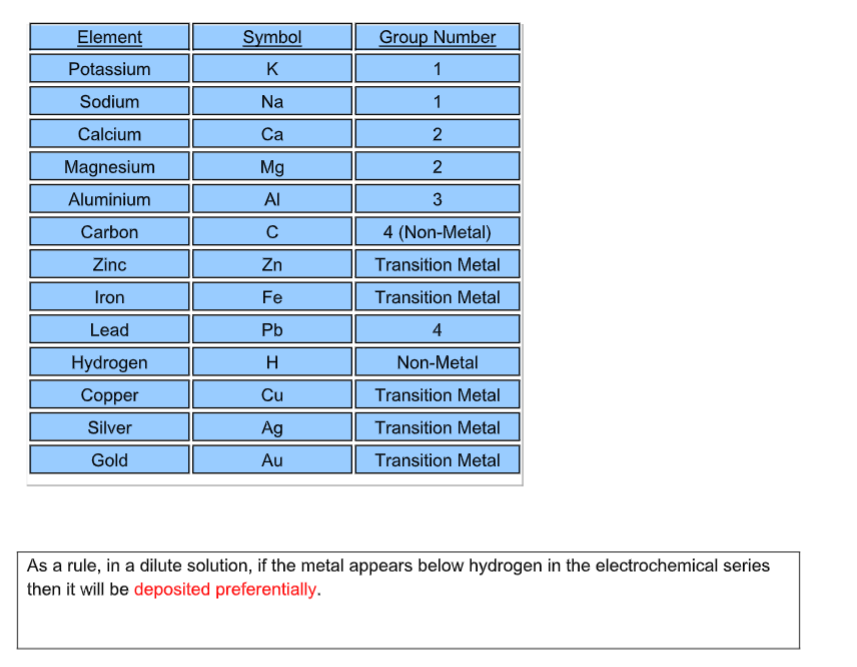
When two ions with similar reactivity are in competition then the relative concentration of the two ions becomes an important factor.
If an electrolyte contains a higher concentration of ions, which are higher in the electrochemical series than those that are lower, then these ions get discharged in preference to the lower ones.
For e.g., a solution of sodium chloride in water contains two types of anions i.e., the chloride (Cl-) ions and the hydroxyl (OH-) ions.
Hydroxyl ions are lower in the electrochemical series than chloride ions.
But if the concentration of chloride ions is much higher than that of the hydroxyl ions then the chloride ions get discharged first.
Electrolysis of NaCl Solution at different Concentration
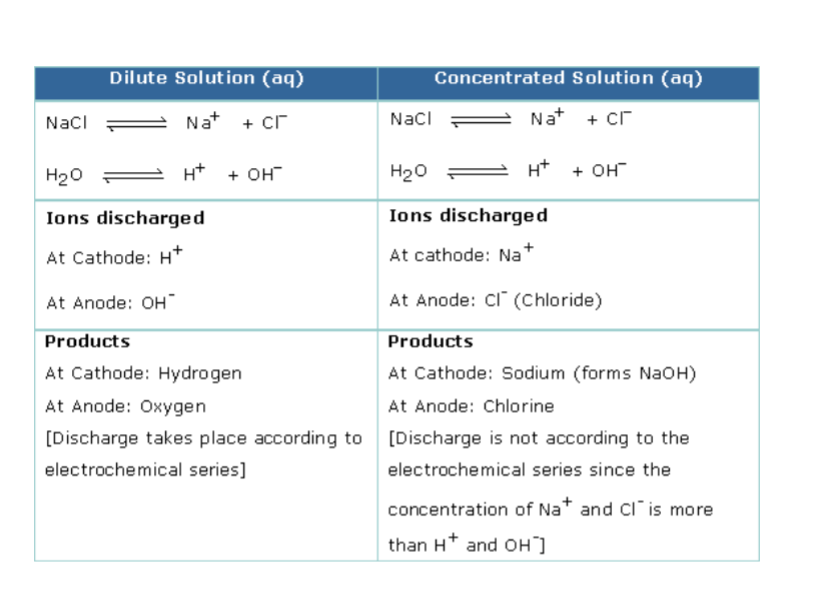
Usually inert electrodes such as graphite or platinum are used for electrolysis.
These electrodes do not interfere with the reactions occurring at the surface of the electrode they simply act as a point of connection between the electrical circuit and the solution.
However, if metal electrodes are used in same metal ion solutions, they can get involved in the reactions by dissolving as ions leaving their electrons behind.
Example: Electrolysis of sodium chloride solution
The ions present in the solution are:
Na+, Cl-, H+, OH-
At the cathode
The positive ions are attracted to the negative cathode.
There is competition between the sodium ions and the hydrogen ions.
As the hydrogen ion hydrogen ion is lower in the electrochemical series than the sodium ion sodium, the hydrogen ions are preferentially reduced and hydrogen gas is produced at the electrode (bubbles are seen)
2H+ + 2e H2
At the anode
There is competition between the negative ions at the positive anode.
The chloride ions compete with the hydroxide ions to release their electrons to the anode.
If the solution is fairly concentrated the chloride ions preferentially lose electrons to become chlorine atoms (and then molecules).
2Cl- Cl2 + 2e
Ions remaining in solution
The ions that are removed from the solution, then, are the hydrogen ions and the chloride ions.
This means that the sodium ions and the hydroxide ions remain in the solution - i.e. sodium hydroxide is also produced.
Note: When the solution of chloride ions is dilute then OH, ions are preferentially released at the anode.
Electrolysis of dilute sulphuric acid (electrolysis of water)
Water is a poor conductor of electricity.
However, it can be made to decompose if some dilute sulphuric acid is added.
A Hofmann voltammeter below can be used to keep the gases produced separate.
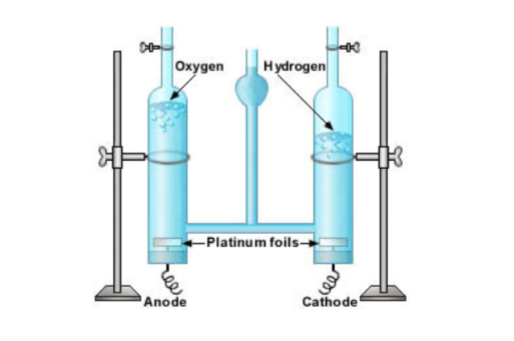
At anode
4OH+(aq) 2H2O(l) + O2(g) + 4e-
At cathode
2H+(l) + 2e- H2(g)
After a while, the volume of gas in each arm can be measured and tested.
Oxygen collects at the anode. The ratio of volumes is about 2:1 for hydrogen and oxygen respectively.
Effectively, this experiment is the electrolysis of water.`
Example: Electrolysis of copper II sulphate solution
The ions present in the solution are:
Cu2+, SO22-,H+, OH-
At the cathode
The positive ions are attracted to the negative cathode.
There is competition between the copper ions and the hydrogen ions.
As the hydrogen ion appears higher in the electrochemical series than the copper ion, copper ions are preferentially reduced and copper metal is deposited at the electrode (pink layer is observed).
Cu2+ + 2e Cu
At the anode
There is competition between the negative ions at the anode.
The sulphate ions compete with the hydroxide ions to release their electrons to the anode.
The hydroxide ions are lower in the series and are preferentially released as oxygen gas (bubbles are seen) and water.
4OH- 2H2O + O2 +4e
OILRIG
Oxidation Is Loss, Reduction Is Gain (of electrons)
Oxidising agents are easily reduced.
Reducing agents are easily oxidized.
Ions remaining in solution
The ions that are removed from the solution, then, are the copper ions and the hydroxide ions, this means that the hydrogen ions and the sulphate ions remain in the solution - i.e.
sulphuric acid is also produced. The solution changes colour from blue to colourless.
Electroplating
Electroplating is a process of depositing a thin layer of a fine and superior metal (like chromium, zinc, nickel, gold etc.)
over the article of a baser and cheaper metal (like iron, copper, brass), with the help of electric current.
Uses
Electroplating is very useful because of the following reasons:
Repair of finer machine parts.
Process
The process of electroplating involves the following steps:
The anode dissolves, depositing the metal ions from the solution on the article in the form of a metallic coating.
The passage of low current is continued for a long time to ensure an even coating.
Electrolysis of copper 11 sulphate solution using copper electrodes
The ions present in the solution are:
Cu2+, SO42-,H+, OH-
At the cathode
The positive ions are attracted to the negative cathode. There is competition between the copper ions and the hydrogen ions.
As the hydrogen ions are higher in the electrochemical series, the copper ions are preferentially reduced and copper metal is deposited at the electrode (a pink layer is observed)
Cu2+ + 2e Cu
At the anode
In this case the electrode is made of copper and it is easier for the copper to dissolve leaving its electrons behind on the anode than for any other ion to be released.
Cu Cu2+ + 2e
Ions remaining in solution
Copper is deposited at the cathode and is dissolved at the anode.
Consequently the concentration of copper ions in solution remains constant.
This can be used as a method of purification of copper as only pure copper is deposited at the cathode.
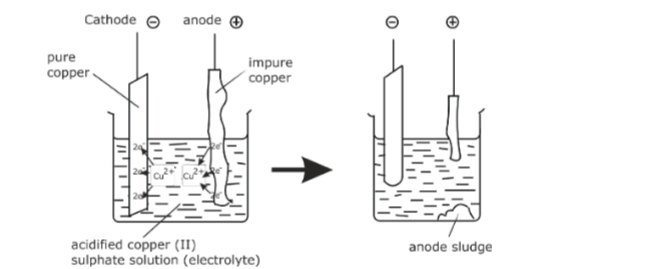
Basic rules for electroplating an object metal M are as follows:
Electrolysis of Lead Bromide.
Lead bromide must be heated until it is molten before it will conduct electricity.
Electrolysis separates the molten ionic compound into its elements.
The reactions at each electrode are called half equations.
The half equations are written so that the same number of electrons take part in each equation.
Pb2+ + 2e- Pb (lead metal at the (-) cathode).
2Br- Br2 + 2e- (bromine gas at the (+) anode).
Lead ions gain electrons (reduction) to form lead atoms.
Bromide ions lose electrons (oxidation) to form bromine atoms.
The bromine atoms combine to form molecules of bromine gas.
The overall reaction is;
PbBr2(l) Pb(s) + Br2(g)
Summary
Reactive metals (more reactive than hydrogen) are never deposited during electrolysis of aqueous solutions.
If the metal ion comes from a metal more reactive than hydrogen then hydrogen gas is liberated at the cathode.
Halide ions (chloride, bromide, and iodide) are released preferentially and if these are not present then the hydroxide ions from the water are released at the anode.
11.0.0 Carbon and Some of Its Compounds
Carbon occurs in nature in large quantities in coal, petroleum and carbonates, notably in limestone CaCO3.
Charcoal is almost pure carbon, but this form of carbon does not have a well defined crystalline form, and is classed as amorphous carbon. Other forms of amorphous carbon are carbon black and lamp black.
Allotropy is the existence of the same chemical in different physical forms.
Allotropes of carbon with different crystalline forms exist. These are diamond, graphite.
Carbon is a chemical element in the periodic table that has the symbol C and atomic number 6.
It is an abundant nonmetallic, tetravalent element, and has several allotropic forms:
Diamond
Diamond is the purest form of natural carbon. It occurs as small crystals embedded in rocks.
These are supposed to have been formed by the crystallization of carbon under extreme pressure and temperature in the interior of the earth.
Nowadays, synthetic industrial diamonds are being manufactured by subjecting graphite to very high temperatures and pressures.
Carbon atoms in diamond have tetrahedral structure.
Each atom of carbon is surrounded by four other atoms that together forms the tetrahedral structure, as shown in the figure 10.1.
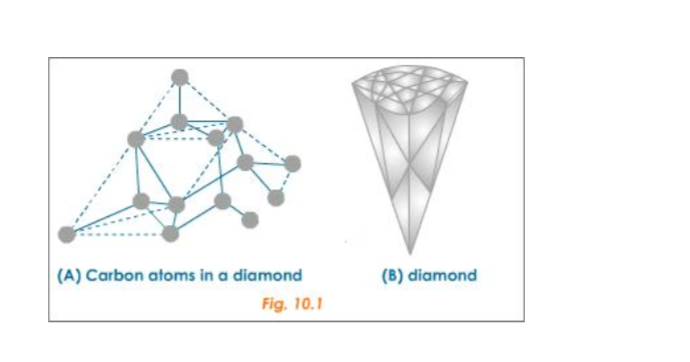
1. Diamond is the purest form of carbon.
2. It is the densest of all allotropes of carbon.
3. Diamond's tetrahedral structure, makes it the hardest naturally occurring substance. It is brittle and transparent.
4. Pure diamond is colourless.
5. Diamond has very high refractive index. When properly cut and polished, it allows the light to undergo total internal reflection that makes it very brilliant.
6. It is transparent to light and X-rays. This property is used to identify a real diamond from a fake one, e.g., glass can be made to shine as brilliantly as diamond but it is opaque to X-rays.
7. Due to catenation there are no free electrons that can move in the structure of diamond. Hence it is a non-conductor of electricity, but extremely good conductor of heat.
8. It is insoluble in all known solvents.
Chemical Properties of Diamond
1. Diamond is chemically very inert. It does not react with any substance at ordinary temperatures.
2. When heated in oxygen to about 800oC, it completely burns to form carbon dioxide. This shows that diamond is pure form of carbon.
3. When heated in the absence of air to 1500oC, the atoms get rearranged to form graphite.
4. Diamond is affected slowly by molten sodium carbonate, forming carbon monoxide.
5. When heated with concentrated sulphuric acid and potassium dichromate it gets oxidised to carbon dioxide.
Uses of Diamond
1. Diamond is used as a gem (except the black variety) due to its brilliance.
2. Black variety of diamond is use for cutting glass, as drilling bits for industrial drills, for polishing other diamonds etc.
Graphite
Unlike the tetrahedral arrangement of atoms in diamond, the carbon atoms in graphite are arranged in the form of hexagonal rings in layers (Fig.10.2).
Each carbon is bonded to only three other carbon atoms in that layer.
Different layers of graphite are held together by rather weak forces. Hence they can slide over one another.
This is one reason why graphite scales off easily and can mark impressions on substrates.
Because of this property, it is also used as a lubricant.
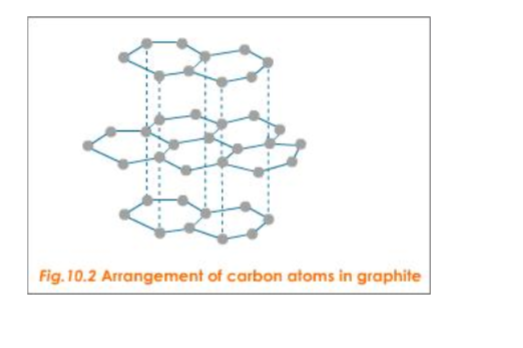
1. Graphite is greyish black crystalline substance.
2. It has a soft and greasy texture, but has a metallic luster.
3. The specific gravity of graphite is only 2.2 g cm-3.
4. Due to the presence of a free valence electron, it is a good conductor of electricity.
5. It is also one of the stable forms of carbon.
6. The structure of graphite has hexagonal rings arranged in layers.
Chemical Properties of Graphite
1. Graphite is inactive and inert to almost all chemicals.
2. It does not burn in air, even if heated to high temperature. But if heated in oxygen, it burns completely to form only carbon dioxide.
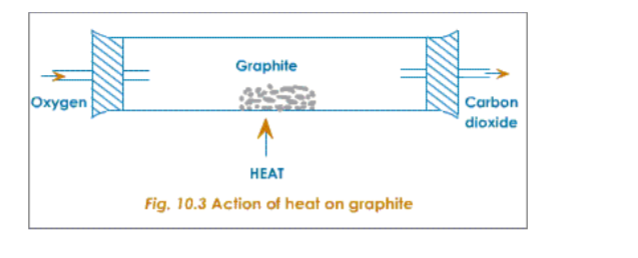
Uses of Graphite
1. Graphite is used in making the 'lead' of pencils.
2. It is used in the production of refractory crucibles, which can withstand very high temperature.
3. Graphite being a conductor of electricity finds application in making electrodes.
4. It is used in making polishes and paints.
5. Graphite is used as lubricant in machines, which have to be operated at high temperatures.
All such machines cannot be lubricated with oils, grease, etc. as they vaporize immediately at the high temperature.
6. It is used for making electrotypes for printing
7. Graphite is extensively used in nuclear reactors, to absorb neutrons.
This helps in moderating the nuclear reaction.
Amorphous carbon
Apart from diamond and graphite, which are crystalline forms of carbon, all other forms of carbon are amorphous allotropes of carbon.
1. Coke
Coke is the amorphous allotrope of carbon, which is derived from coal.
When coal undergoes destructive distillation, it yields two allotropes of carbon, namely coke and gas carbon.
Destructive distillation is a chemical process, which involves is the breaking up of a complex substance by heating it in the absence of air.
Uses of coke
It is a very good fuel and when ignited it burns almost with no smoke.
It is a non-conductor of heat and electricity.
It acts as a good reducing agent and is extensively used in the production of producer gas, water gas and hydrogen.
2. Sugar Charcoal
Sugar charcoal can be obtained by dehydrating cane sugar, either by treating it with concentrated sulphuric acid or by heating it in the absence of air.
It is the purest form of the amorphous variety of carbon.
It is used in the preparation of artificial diamonds.
3. Wood Charcoal
Wood charcoal is obtained by the destructive distillation of wood. The chief products formed are wood charcoal.
Properties.
Wood charcoal is black, porous, brittle and soft.
Though denser than water it can float on water, as it contains plenty of air bubbles trapped in the pores.
Wood Charcoal is not a conductor of electricity.
Uses
It is also used as a decolourising agent for sugar, oils, alcohol, petroleum products, etc.
4. Animal Charcoal
It is prepared by the destructive distillation of bones of animals.
It is porous and can adsorb colouring matter.
It is mostly used in sugar industry to decolourise sugar.
Chemical properties of carbon
1. The combustion of carbon:
Carbon reacts with oxygen to form two oxides, carbon dioxide, CO2, and carbon monoxide CO.
The proportions of these two oxides formed during combustion depend on the conditions.
At about 500 ºC, carbon dioxide is produced almost exclusively, provided that oxygen is in excess:
C(s) + O2(g) CO2(g)
At higher temperatures, or when the supply of oxygen is restricted, carbon monoxide is the main product.
2C(s) +O2 (g) 2CO (g)
2. Reaction with acids
Carbon reacts with concentrated sulphuric acid and concentrated nitric acid.
Nitric acid is a powerful oxidizing agent. Both acids oxidize carbon to carbon dioxide gas.
Carbon + sulphuric acid carbon dioxide + sulphur dioxide +water
C(s) + 2H2SO4(conc) CO2(g) + SO2(g) + 2H2O(l)
Carbon + nitric acid carbon dioxide + Nitrogen (IV) oxide + water
C(s) + 4HNO3 (conc) CO2(g) + 4NO2(g) + 2H2O(l)
3. Reducing action of carbon
When carbon is mixed with iron (III) oxide and heated strongly, pure iron metal is produced.
Carbon monoxide + iron (III) oxide carbon dioxide + iron.
3CO(g) + Fe2O3(s) 3CO2(g) + 2Fe(l)
Carbon (IV) oxide:
Carbon dioxide is easily prepared by the action of dilute hydrochloric acids on metal carbonates (normally calcium carbonate or marble).
Vigorous effervescence occurs as bubbles of carbon dioxide are liberated.
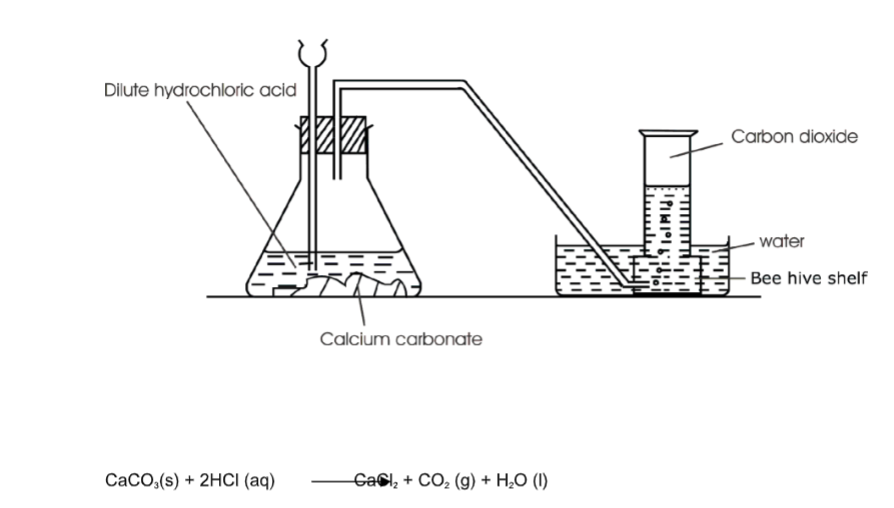
Since carbon dioxide is 1.53 times as heavy as air, it usually collected by upward displacement of air.
In this case, it is collected by downward displacement of water.
Properties of carbon (IV) oxide
Physical properties
Carbon dioxide is a colourless gas with a faint pungent smell.
It does not burn or support combustion, except in extreme cases, and is not poisonous (it is the gas in fizzy cool drinks).
It can however cause death by suffocation, when it is present in sufficient concentrations.
Carbon dioxide is a linear molecule. The gas condenses to a liquid at 0 ºC under a pressure of 35 atm.
At normal pressure, carbon dioxide condenses directly to a solid at -78.5 ºC.
This solid, known as dry ice, is widely used as cooling agent.
Solid carbon dioxide does not melt under conditions of normal atmospheric pressure, but passes directly into the gas phase, a process known as sublimation.
Chemical properties
1. Reaction with water
When carbon dioxide is dissolved in water, carbonic acid, H2CO3, is produced in small quantities:
CO2 (g) + H2O (l) H2CO3 (aq) Carbonic acid is a weak diprotic acid which gives rise to salts known as carbonates, which contain the carbonate anion CO32-.
2. Reaction with limewater
Test for carbon dioxide
Limewater is a clear colourless solution of calcium hydroxide (slaked lime).
Calcium carbonate is precipitated when carbon dioxide is passed through a clear solution of calcium hydroxide in water.
The lime water turns milky serving as a test for carbon dioxide liberation.
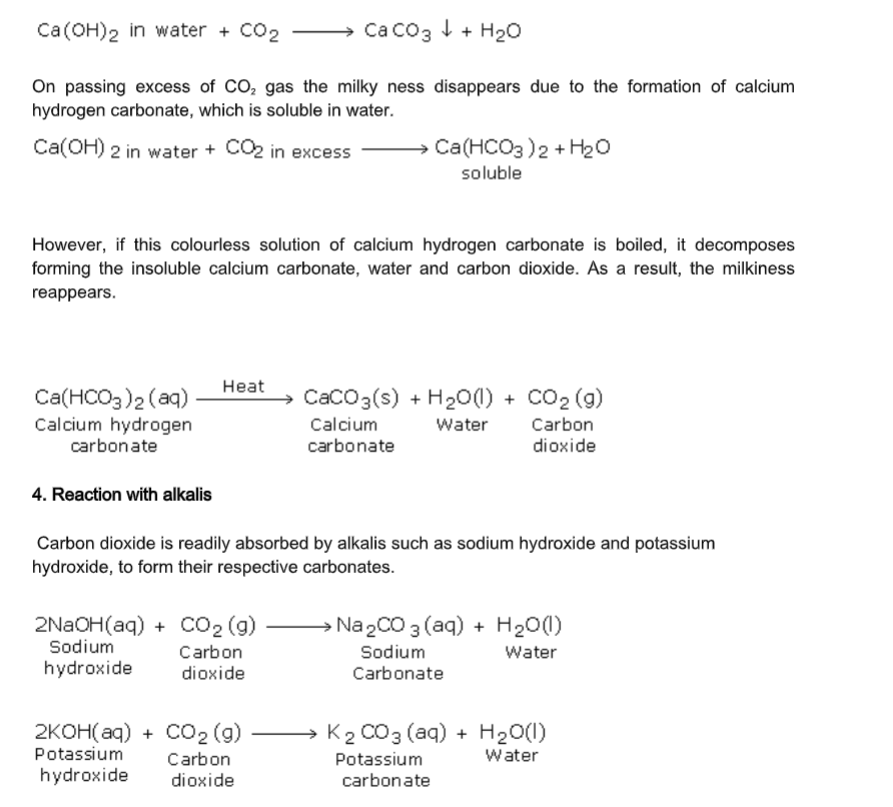
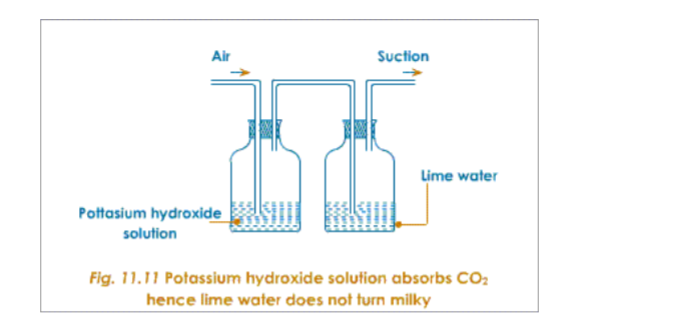
5. Nature
Carbon dioxide is slightly acidic. It turns blue litmus paper red.
During rainy season, blue litmus paper kept open in the laboratory slowly turns red, due to the presence of carbon dioxide in air.
6. Combustibility
Carbon dioxide is neither combustible, not a supporter of combustion.
A burning splinter or a burning candle gets put off, but metals like potassium, sodium, magnesium etc. continue to burn in carbon dioxide.
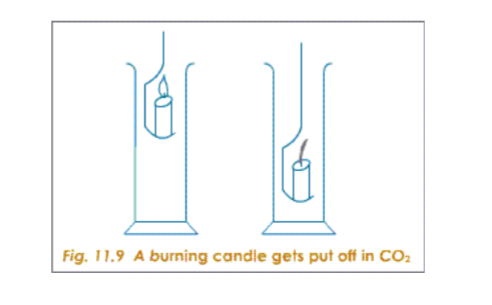
Ignite a ribbon of magnesium, and introduce it in the jar of carbon dioxide. The magnesium ribbon continues to burn in carbon dioxide.
Deposits of carbon can be seen on the inner sides of the jar.
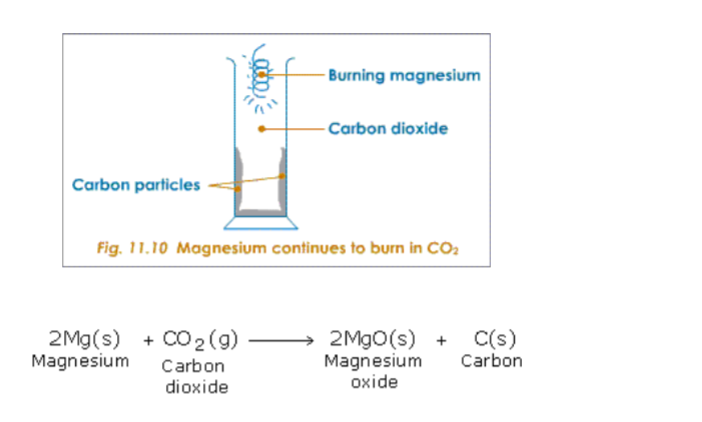
7. Action on heated carbon
When carbon dioxide is passed over red-hot carbon in the form of coke charcoal, the carbon dioxide loses one of its two atoms of oxygen.
As a result, carbon dioxide gets reduced and becomes carbon monoxide. At the same time the hot carbon also gets converted to carbon monoxide.
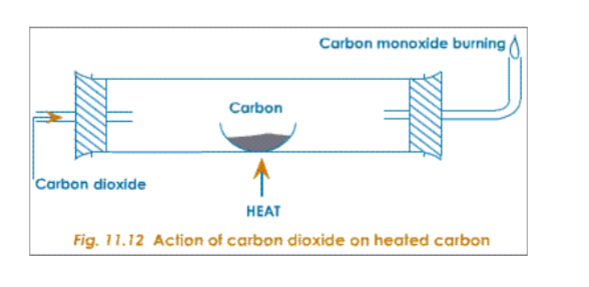
1. In nature
a) Carbon dioxide is used in photosynthesis by green plants to produce carbohydrates.
b) To induce natural breathing.
2. To extinguish fires
Soda-acid fire extinguishers produce carbon dioxide to put out fires.
3. As a refrigerant
Solid carbon dioxide called "Dry ice" can provide temperatures as low as -109.3o F.
It is superior to ordinary ice, for the following reasons:
i) It provides much lower temperature than ice.
ii) It lasts longer.
iii) It freezes faster.
iv) It does not wet the food being chilled, as it sublimes directly into gaseous state.
4. Manufacture of fertilizer
Carbon dioxide is used extensively in the manufacture of urea, an important in nitrogenous fertilizer.
5 In the baking industry
Baking powder is used in all the food preparations. The addition of baking powder during baking produces carbon dioxide which makes the dough "rise".
The small pores in a loaf of bread are the spaces in which carbon dioxide was formed .
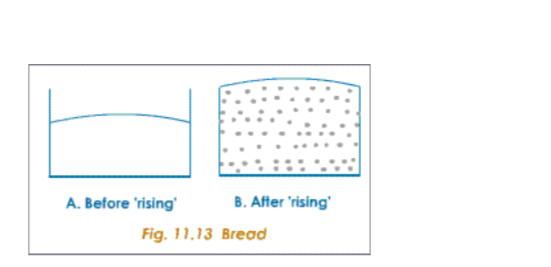
It produces carbon dioxide by anaerobic respiration.
Baking powder contains starch, sodium hydrogen carbonate and an acid forming ingredient, such as tartaric acid of calcium hydrogen phosphate [Ca(H2PO4)2] or alum [Na2SO4.Al2(SO4)3.24 H2O].
6. In medicine
A mixture of 97% oxygen and 3% carbon dioxide, called carbogen is used to revive persons affected by carbon monoxide poisoning, pneumonia, asphyxiation etc.
7. Manufacture of aerated drinks
Carbon dioxide is extensively used in aerated drinks.
Increasing the pressure increases the solubility of the gas.
The fizz in the drink is due to carbon dioxide being liberated when the pressure is reduced.
8. Food storage
It is use to fill silos (storage bins) and containers, that are used for storing food grains.
After the silos are packed with the food grains, carbon dioxide is pumped into the silos from the top.
The gas being heavier then air, slowly sinks down, pushing out the air in between the grains.
This prevents the growth of bacteria, fungus, etc. on the grains.
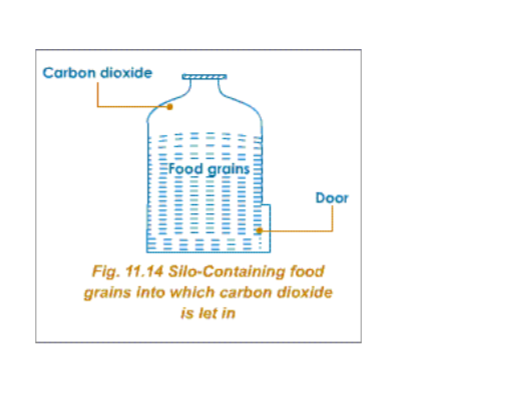
Dry ice is used to create artificial clouds as special effects, for stage shows, films, discotheques etc.
Dry ice is dropped into water; absorbing heat from the water, the solid carbon dioxide sublimes, carrying with it a lot of water vapor.
These two together form thick white 'clouds'.
But unlike real clouds, which are formed above due to the low vapor density of water vapor, the artificial cloud fills the floor of the stage, as the vapor density of carbon dioxide is 22.
So while the lower part of the body of the artist is covered by 'cloud', the upper half is visible.
Carbon (II) oxide (Carbon monoxide):
Carbon monoxide is an odourless, tasteless and colourless gas, which is insoluble in water.
It is extremely poisonous.
Under no circumstances must the gas be inhaled or smelled.
It is not usually prepared in a school laboratory.
If need be, the gas should be prepared in a fume chamber.
Preparation of carbon monoxide
1.By dehydrating oxalic acid with hot concentrated sulphuric acid
Carbon monoxide is prepared with the help of oxalic acid and concentrated sulphuric acid as shown below.
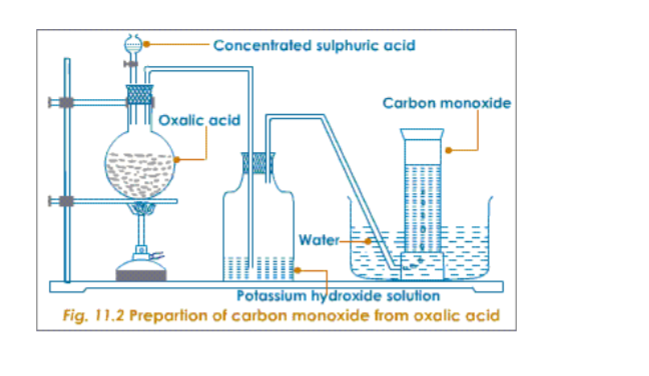
The product left behind due to this reaction, is a molecule of carbon dioxide and a molecule of carbon monoxide.
The carbon dioxide can be removed by passing it through a concentrated solution of potassium hydroxide.
2. Preparation of carbon monoxide by dehydrating formic acid
Formic acid has the formula HCOOH. Formic acid can also be dehydrated in a similar way by hot concentrated sulphuric acid.
Sulphuric acid removes two atoms of hydrogen and one atom of oxygen as a molecule of water from it, and leaves behind one molecule of carbon monoxide.
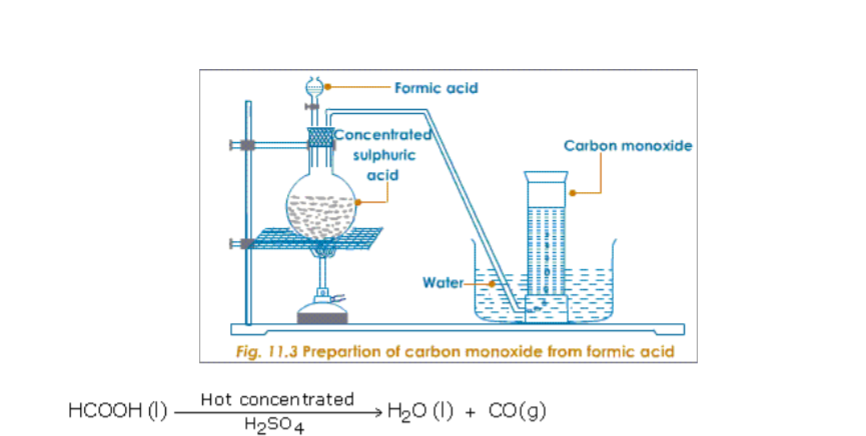
For this reason, it is found in the exhaust gases of motor vehicles, as well as in cigarette smoke. Indoor fireplaces can be a serious hazard if ventilation is poor.
Industrial preparation
It is prepared industrially (mixed with hydrogen) by passing steam over coke at temperatures above 900 ºC. The resulting gas mixture is known as water gas, and it is used as a fuel:
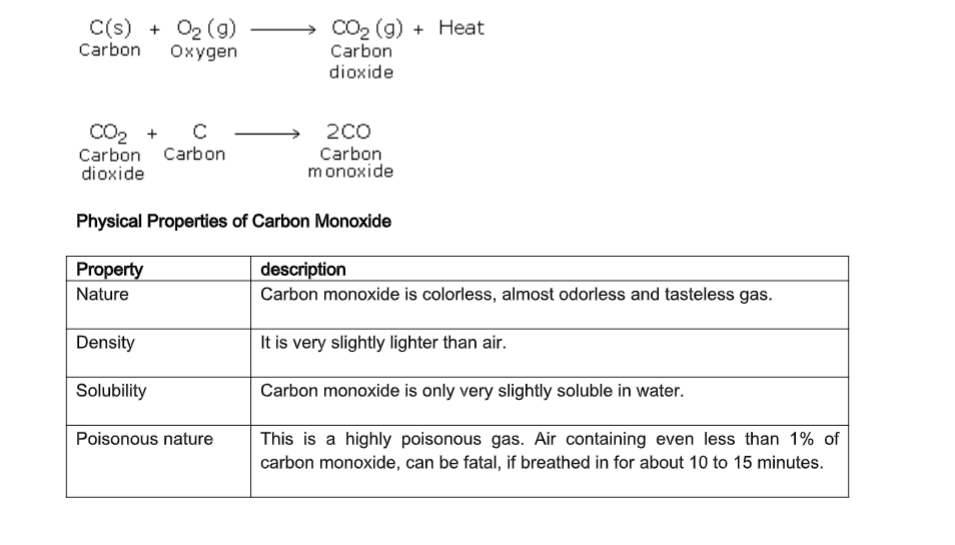
a) Nature
Carbon monoxide is a neutral oxide. It is neither acidic nor basic.
b) Stability
It is very stable and cannot be decomposed by heat.
c) Combustibility
It is a combustible gas. It burns well in air or oxygen to form carbon dioxide. The formation of carbon dioxide is tested by passing it through a solution of lime water.
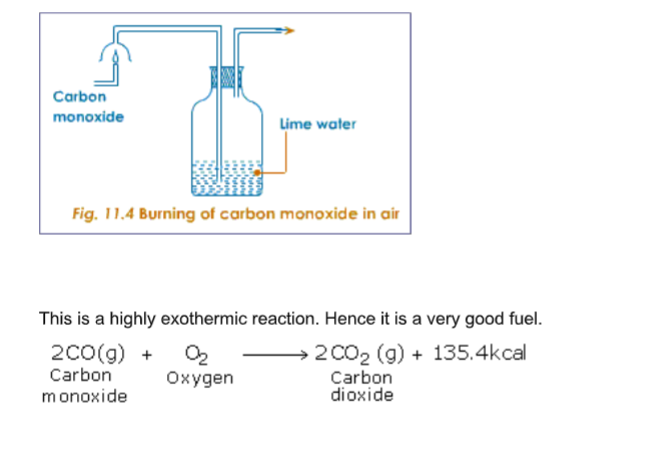
d) Reducing property
Carbon monoxide is a powerful reducing agent.
When CO is passed over heated metallic oxides, it takes away the oxygen to form carbon dioxide and reduces the oxides to their respective metals.
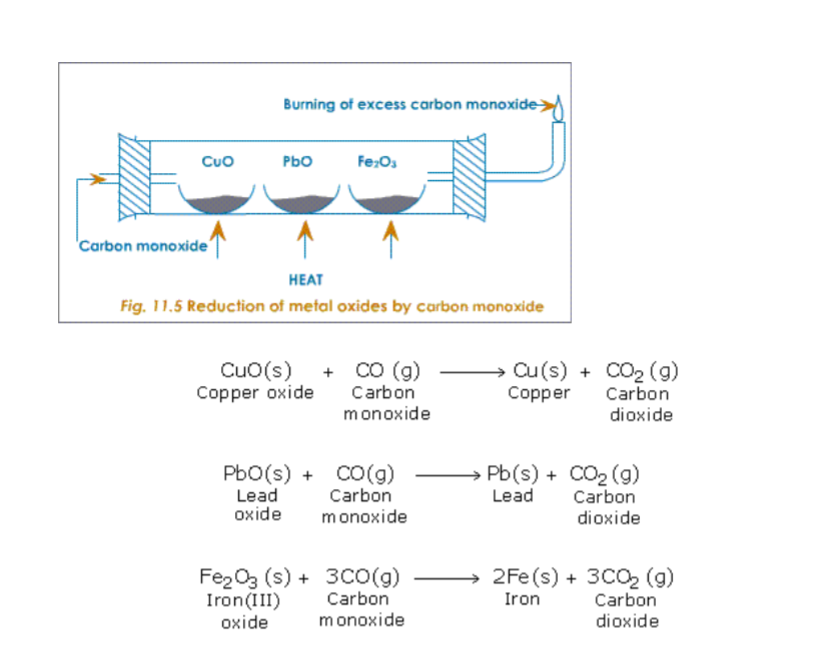
And Sodium Carbonate
Sodium Carbonate (Na2CO3)
Popularly known as washing soda or soda ash, sodium carbonate is a commercially important compound.
In earlier days, it was obtained from the ash of plants and from natural deposits in India and Egypt.
Manufacture of Sodium Carbonate
Principal Reactions
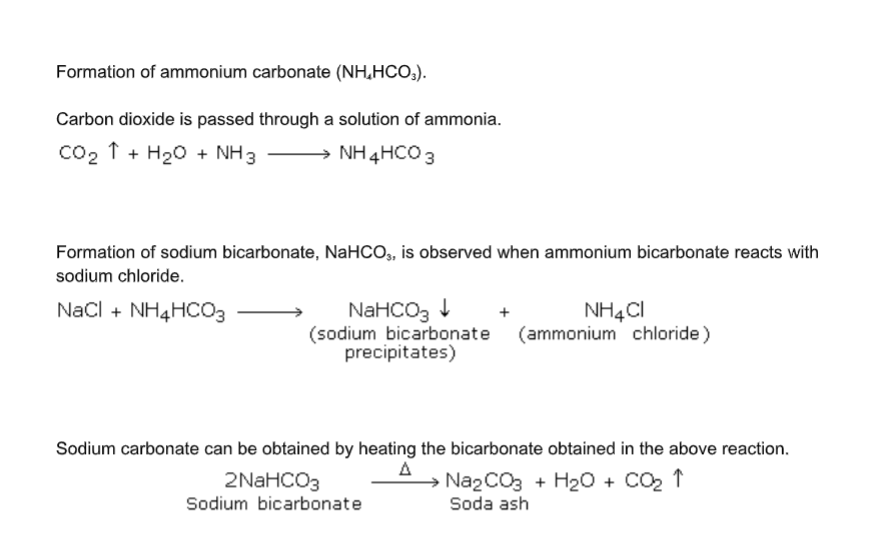
The first step in the manufacture of sodium carbonate is to generate carbon dioxide. This can be got by heating limestone.
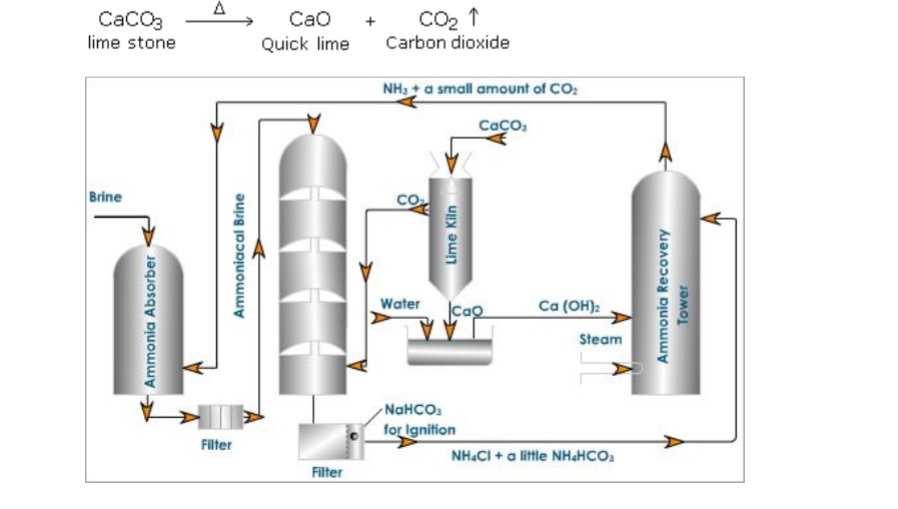
Saturation of Brine With Ammonia
Brine solution is pumped into the ammonia absorber.
From the ammonia recovery tower, ammonia mixed with a little carbon dioxide enters the absorber and saturates brine.
Impurities of calcium and magnesium present in brine are precipitated as carbonates.
These impurities can be removed by pumping the liquid through the filter press and then passed through cooling pipes.
Carbonation
Ammoniacal brine next enters the carbonating tower from the top.
This tower is partitioned using horizontal plates that have a central hole and covered with a perforated plate.
The ammoniated brine meets the rising stream of carbon dioxide to form crystals of sodium bicarbonate and ammonium chloride, which remains in the solution.
Filtration
The viscous milky liquid from the carbonating tower is filtered using a rotary vacuum filter.
The solid sodium bicarbonate left on the filter cloth can be periodically scrapped.
The filtrate is pumped to the top of the ammonia recovery tower.
Calcination
Sodium bicarbonate is then heated strongly to form anhydrous sodium carbonate or soda ash.
Recrystallization
To get washing soda (Na2CO3.10H2O) from soda ash, anhydrous sodium carbonate is dissolved in water and recrystallized.
NaO2CO3 + 10H2O -> NaO2CO3.10H2O
(Washing soda)
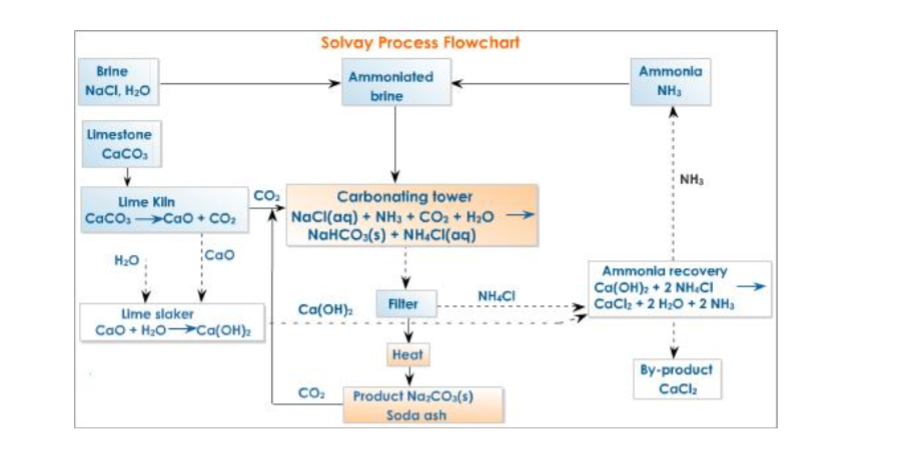
The calcium oxide or quick lime formed in the lime kiln is changed to slaked lime [Ca(OH)2] and pumped into the ammonia recovery tower.
This then reacts with the filtrate from step 3 (filtration) to regenerate ammonia.

Properties of Washing Soda
Efflorescence
Efflorescence is the loss of water of crystallization from a hydrated salt, when exposed to air.

Carbon Cycle
The cyclic changes that carbon undergoes in nature is referred to as the Carbon cycle.
Carbon in the form of carbon dioxide gets added to the air and gets removed from the air constantly.
This addition and subtraction is so well balanced that the percentage of carbon dioxide remains remarkable steady at 0.03 to 0.04
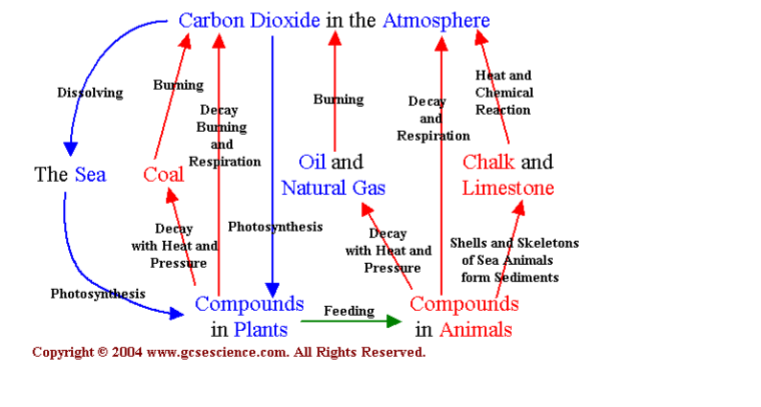
1. By the respiration of living organisms.
2. By the combustion of carbon present in carbon compounds, such as wood, coal, coke, petroleum oil, vegetable oil, alcohol etc.
3. By the decay of organic matter, like the dead bodies of animals and plants.
4. From chemical industry such as, heating of limestone, fermentation of molasses to form alcohol, in beer and wine making processes etc.
Removal of carbon dioxide from air
1. By photosynthesis
Green plants take in carbon dioxide to synthesize carbohydrates.
The carbohydrates formed are consumed by animals, digested, absorbed and used in respiration.
During respiration, the carbohydrate is oxidised to carbon dioxide, which is released into the air.
2. By dissolution
Carbon dioxide of the air dissolves in water, forming a very dilute solution of carbonic acid.
This reaction is an unstable one and depends upon water temperature.
If water gets warmer, some of the dissolved carbon dioxide gets released into the air.
Answers
Structure of the atom

(ii) 2, 8; 7;
2. (a) (i) 35 protons (twice);
44 neutrons;
46 neutrons;
(ii) each isotope 50%;
3. (a)
17 17 18
17 17 20
(b) (i) (0.75 × 37) + (0.25 × 35) = 35.5;;
(ii) 71;
4. (a) negligible/(approximately) ; [not zero]
0;
1;
+1;
(b) (i) chlorine;
17 electrons;
(ii) 17
5. (a) Q
(b) R
It has a smaller radius, so the attraction of the electrons to the nucleus is stronger.
OR
It has fewer shells so less screening of the outer electrons from the nucleus, stronger attraction to the nucleus.
Assessment 2
1. (a) An explanation to include two from:
1. all the elements react with sodium in the same way (to form similar compounds);
2. form similar coloured halides / compounds with silver;
3. all silver halides / compounds insoluble in water;
4. all silver halides affected by light;
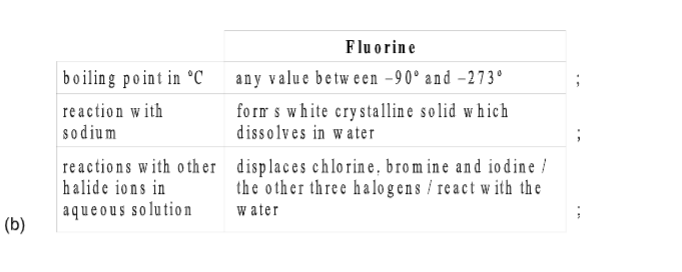
(ii) 1 ;
(iii) caesium / f rancium
(iv) noble gas ; unreactive element;
(b) 2Cs + Cl2 2CsCl
formula CsCl;balancing;
3. (a) A description to include three from:
• fizzes/bubbles;
• moves about;
• floats on water;
• white smoke;
• burns with yellow flame;
• dissolves/gets smaller;
plus 1 communication mark for presenting relevant information in a form that suits its purpose;
(b) hydrogen;
(c) alkaline;
(d) increases;
4. (a) (i) S;
(ii) T;
(iii) P/Q;
(iv) P/Q;
(v) R/S/T;
5. (a)(i) any group 0 gas;
(ii) glows with colour / inert;
(b) Boiling point increases as the atomic number increases;
(c) (i) (atoms of same element with) different number of neutrons;
(ii) A calculation to include:
; = 20.18 / 20.2;
(iii)An explanation to include:
1. full / complete outer shell;
2. atoms do not share / lose / gain electrons
Assessment 3
1. (a) both (forms of) carbon/giant covalent;
(b) An explanation to include:
1. different arrangement;
2. of carbon atoms;
[Accept appropriate relevant statements for 1 mark each]
(c) An explanation to include two from: diamond
1. all electrons involved in bonding/four bonds per atom;
2. no delocalised/spare electrons; graphite
1. three bonds per atom;
2. delocalized/spare electrons;
[To gain the second mark, electrons must be mentioned]
(d) C(s) + O2(g) -> CO2(g)
LHS correct;
RHS correct;
3 state symbols;
2. (a) (i) 4 electrons/same number of electrons in outer shell;
(ii) A suggestion to include:
Either
• carbon and silicon both in group 4/same group/same number of electrons in outer shell;
• compounds of elements in same group have similar properties;
or
• both covalently bonded;
• stated property is similar;
(b) (i) Bonding - covalent;
Reason - between non-metallic elements/both electrical
insulators/unlikely to gain/lose four electrons;
(ii) Structure - giant/(lattice) structure;
[Reject macromolecular]
Reason - high melting point;
(iii) A description to include:
• molecules held together;
• in regular pattern/lattice;
3. (a) (i)
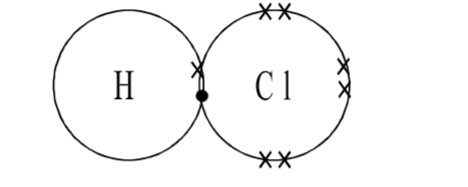
fully correct;
[Deduct 1 mark for incorrect inner electrons]
(ii) weak forces between molecules;
(b) (i)
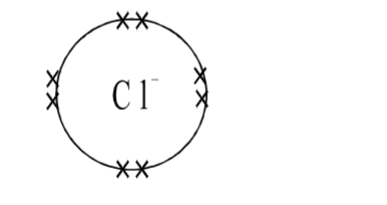
[No mark if incorrect inner electrons]
(ii) 2H+ + 2e- H2
formulae of H+ and H2;
fully correct;
[Allow H+ + e- -> H for 1 mark]
4. (a) 3
(b) one electron on each hydrogen atom;
six outer electrons on oxygen atom;
both shared pairs shown;

(ii) shared pair identified;
5. (a) (i) electron(s);
(ii) chloride;
(iii) strong/high;
(b) shared; (pair of) electrons;
reject other particles for second mark
(c) (i) covalent (bonding);
(between) non-metal (atoms); [Must clearly imply both]
(ii) 35.5;
Assessment 4
1. (a) (i) to neutralise all the acid;
(ii) zinc oxide/hydroxide;
(b) (i) Ag+(aq) + Cl-(aq) AgCl(s);
formulae;
state symbols;
(ii) An explanation to include:
1. silver chloride insoluble;
2. no reaction/silver carbonate insoluble in acid;
2. (a) Either use safety glasses/wear apron/tie back hair;
or avoid contact with lead compounds/acid
(b) (i) C/sulphuric acid;
(ii) diagram of measuring cylinder/pipette/burette;
label;
3. (a) B D A C E;;
(b) (i) measuring cylinder/burette/pipette;
(ii) wear goggles/gloves;
(c) precipitate;
(d) filter funnel;
filter paper,
(e) put in warm place e.g. oven, radiator etc;
4. (a) (i) chlorine;
[Reject chloride]
(ii) Cl;
[Reject CL / Cl2]
(b) (i) 1 / alkali metals;
(ii) 1 / alkali metals;
(iii) both (compounds of) group 1 / alkali metals / (metals) in same group;
(c) solid disappears / dissolves / (colourless) solution formed;
KCSE Revision Notes Form 1 - Form 4 All Subjects
Basic Chemistry Interview Questions and Answers Pdf Basic Chemistry Questions and Answers Basic Chemistry Questions and Answers Pdf Chemistry Form 1 Notes Chemistry Form 1 Notes Free Download Chemistry Form 1 Notes Pdf Chemistry Form 1 Notes Pdf Download Chemistry Form 2 Notes Chemistry Form 2 Questions and Answers Chemistry Form 2 Salts Chemistry Form 2 Structure and Bonding Chemistry Form 3 Notes Chemistry Form 3 Notes Pdf Chemistry Form 4 Exercise Chemistry Form 4 Notes Chemistry Form 4 Notes Chapter 1 Chemistry Form 4 Notes Chapter 2 Chemistry Form 4 Notes Chapter 3 Chemistry Form 4 Notes Download Chemistry Form 4 Notes Pdf Chemistry Form One Book Pdf Chemistry Form One Notes Pdf Chemistry Form One Pdf Chemistry Multiple Choice Questions and Answers Pdf Chemistry Objective Questions for Competitive Exams Chemistry Question and Answer With Explanation Chemistry Questions and Answers Chemistry Questions and Answers for High School Chemistry Questions and Answers Pdf Chemistry Questions and Answers Pdf for Class 12 Chemistry Quiz Questions and Answers for Class 12 Chemistry Quiz Questions and Answers Multiple Choice Chemistry Spm Notes Download Download Chemistry Form 2 Notes Download Klb Chemistry Book 3 Form 3 Chemistry Questions and Answers Form 3 Chemistry Questions and Answers Pdf Form Three Chemistry Book Pdf Hard Chemistry Questions and Answers High School Chemistry Questions and Answers Pdf Inorganic Chemistry Multiple Choice Questions With Answers Pdf Inorganic Chemistry Questions and Answers Pdf Interesting Chemistry Questions Klb Chemistry Book 1 Download Klb Chemistry Book 1 Pdf Klb Chemistry Book 2 Notes Klb Chemistry Book 2 Notes Pdf Klb Chemistry Book 3 Notes Klb Chemistry Form 2 Notes Klb Chemistry Form 2 Pdf Klb Chemistry Form 3 Pdf Spm Chemistry Revision Notes Tricky Chemistry Questions With Answers
Scholarship 2025/26
Current Scholarships 2025/2026 - Fully FundedFull Undergraduate Scholarships 2025 - 2026
Fully Funded Masters Scholarships 2025 - 26
PhD Scholarships for International Students - Fully Funded!
Funding Opportunities for Journalists 2025/2026
Funding for Entrepreneurs 2025/2026
***
